#And converting them mostly into smaller more stable forms
Text
BMI is bullshit, you will never catch me defending BMI or its proponents, but calories, and by extension, calorimeters are actually a pretty effective tool for understanding how much energy a human can derive from a piece of food, I know the dismissive tagline is "You'll notice your body is different from a tub of water placed above a burn chamber" but also, in many significant ways it is identical to a burn chamber and a tub of water, at least when it comes to specific processes. Like, I think the way we think about calories isn't great, there is an absolute over-focus on simply counting at the input level, but overcorrecting into 'the Calorie as a unit is entirely meaningless' isn't the way forward either, IMO. It seems like giving up on the idea that we can use things to learn about other things, when, in fact, comparisons to similar but easier to understand systems are how we've gone about understanding basically everything we currently understand about the universe, which is quite a lot.
#Like your body isn't *just* going to use that energy to heat up some water#But also keeping you (a bag of water) warm is a large part of your metabolism's job#And the heating of an object with a known specific heat capacity is a good way to measure the energy involved in a process#And the way your body breaks down food is reasonably similar to the combustion process#Particularly from an energy capture standpoint#Because it is taking the complex hydrocarbons that make up food#And converting them mostly into smaller more stable forms#And using the difference in structural energy of those things as energy for various chemical processes#Energy is very well known to be extremely interchangeable the amount of energy it takes to heat water does not care where it came from#And likewise the energy to heat water can instead be used to make ATP to provide stored energy for chemical processes#Or the various other ways the human body works bless it#Anyhow this is a technical quibble with a post whose general thrust I agree with#Which is why it is its own post#Don't get me wrong I'm also not endorsing any diet or dietician's understanding of Calories and how they work#But the Calorie as a unit is both useful and meaningful in understanding the human metabolism#That's the hill I'm willing to stake out here and there's a large post in circulation with a comment that is in opposition to that#And it is my stance that their heuristics are fundamentally wrong and broken they are using bad reasoning#The exact quote is full of 'in my understanding' and 'just a thought's#And like bro your understanding is sophomoric at best#That is what we do but you didn't stop to ask why we do it or if that actually makes any sense#Literally huge portions of modern thermodynamics are based on the ability of experiments like this to accurately measure energy release#And like IDK maybe you can upend it maybe your understanding is better#But pointing out the basic mechanism without understanding how or why it works isn't going to be what does it
14 notes
·
View notes
Photo
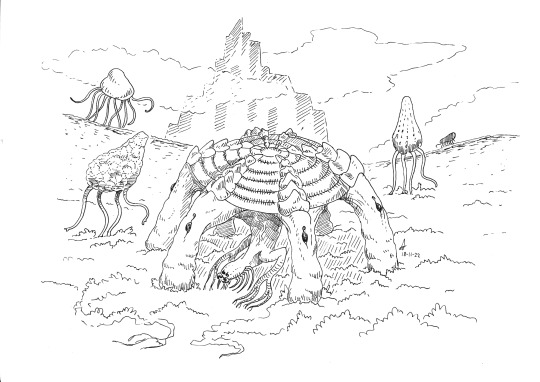
The Perfect Being
A Seraph in the world-garden, surrounded by meat creatures. These beings did not evolve. Erecting the ziggurat in the background took a million years of work.
(DeviantArt)
This species did not arise from previous ancestors through evolution by natural selection: rather, it was created in its present form by a powerful, intelligent Creator for the purpose of glorifying Itself. The Creator acted within the constraints of the physics we know -- entropy, gravity, chemistry -- but, within those constraints, It had the power to shape Its creations however It willed. No requirement to develop them gradually through functional intermediates; no need to repurpose old structures for new functions; no necessity to make them respond to changes in the environment, or to antagonistic relations with other species.
The Creator chose a terrestrial planet somewhat larger than Earth, with weak but not negligible tectonic activity. The surface is about 60% water, and land is distributed in hundreds of islands ranging in size from Java to Australia, mostly placed along the Equator and the Polar Front, where wind and rain abund. Oceanic plates move just enough to create arcs of volcanic islands that link the mini-continents to each other. Proximity to water and a thick, moist atmosphere redistribute heat, ensuring balmy tropical temperatures worldwide. The rotation axis is perfectly perpendicular to the orbital plane, and kept stable by a large moon, so that there are no distinct seasons.
Land is almost entirely covered by a single biome: thick, springy tangles of a dark red sponge-like plant that absorbs sunlight at high efficiency, filling the atmosphere with oxygen and smoothing any unevenness in the ground; the roots secrete corrosive acids that make short work of minerals, but the upper surface is nothing but a soft moss-like carpet. The "animals" that move upon this surface suck fluids from the plant carpet through slender tube feet, converting them into dense proteins and fats that they store in their lumpy body; others burrow through the plant mass to ensure air circulation.
There are no predators or parasites; the population of these grazers is kept in check only by their tendency to spontaneously die of overcrowding, as a certain pheromone they secrete grows past a critical threshold. All animals reproduce asexually, and an extremely severe error-correcting mechanism aborts the process whenever a new mutation occurs. Dead bodies are quickly reabsorbed by the carpet.
This bare-bones biosphere exists for the benefits of the Creator's own chosen ones, which we will call Seraphim.
Their body is roughly starfish-like, a bit over 2 meters across, with a six-fold radial symmetry that allows them to move in any direction; it is supported by six muscular legs, each topped with an eye and an ear. The pads at the end of each limb contain sensitive tactile and chemical sensors that can measure the quality and depth of the plant carpet underfoot. From the center of the ventral side emerges a retractile head that carries a pair of smaller, more sensitive eyes and a range of chewing and manipulatory appendages. Largest of these are two lateral arms that end in branching tentacles, fit both to lift heavy loads and to handle delicate objects. The dorsal side of the body is covered by a dark flexible shell.
This shell is composed by thin overlapping layers of monocrystalline silicon that, when exposed to sunlight, accumulates electric potential through the photovoltaic effect, in practice acting as a solar panel. This electric potential is used to recharge energy-storing molecular bonds. Even though more efficient than photosynthesis, this is still not enough to feed a powerful, proactive intellect; thus, the photovoltaic shell has only an accessory role. The Seraphim draw most of their energy by grazing on the springy plant carpet or by eating the fat, slow-moving grazers, which can be easily grabbed and chewed at any time.
Metabolism is not far different from what we observe on Earth: reduced organic carbon reacts with atmospheric oxygen to release energy and carbon dioxide as waste. A ring of six hearts pumps blood through vessels from the central body into all appendages and back; vents in the ventral surface directly enrich blood with oxygen as it passes through each heart. Undigested food is reduced to an ash-like substance and compressed into pellets that are expelled from underneath the head. There are no gut bacteria: the Seraphim on their own can digest every compound in their food, and synthesize all chemicals they require from sugars, aminoacids, and minerals.
The brain is quite large (about 7 kg), divided in six redundant lobes, and protected under spongy layers beneath the shell. The reason for its size is the presence of channels in which flows what we will call the neural fluid. This is an extremely complex mixture of polypeptides, each "tagged" to interact with a particular neuron or set of neurons, chemically encoding the sum of information stored in the brain. It is, effectively, memory in a liquid form, as the activity of neurons constantly releases and destroys tagged polypeptides.
When two Seraphim wish to exchange information, the most complete way to do so is to exchange a part of neural fluid, which can be injected through a cannule located under the mouth. Each part flushes its own fluid from one or more lobes of its brain, and circulates for a while the partner's through it. In such a way, a Seraph can experience the very same impressions and thoughts of another one.
This form of communication is, of course, slow, energy-consuming, and only effective upon contact. (One can see from the expense of this arrangement why this species cannot subsist on light alone.) The Seraphim can sacrifice information density in favor of speed and range by communicating with radio waves. Controlled radio waves are generated thanks to a muscular organ above the brain, similar to the "batteries" of electric eels, which sends pulses of electricity across an insulated gap. The resulting waves are received by innervated conductive rods in the supporting legs, sheathed with crystalline zinc oxide to rectify the signal.
All appendages can be regenerated after loss, and voluntarily shed if heavily damaged. The Seraphim can only die before their time due to starvation, impact damage from a great fall or a collapse overhead, extensive bloodloss, or loss of enough appendages at the same time to overwhelm regeneration. Nevertheless, they are not immortal: even such beings inevitably accumulate small damages over time, and harmful mutations as their cells divide. Thus, at the age of a couple centuries, each Seraph simply dies as its brain shuts off, sending around a chemical that induces the plant carpet to quickly overgrow and dissolve the body.
Since the environment does not change significantly, and there are no parasites to race against, the additional genetic diversity produced by sexual reproduction is not necessary. The Seraphim all reproduce asexually, by parthenogenesis, conceiving and giving birth to clones of themselves whenever they sense the population density is under a certain threshold. During the process, the neural fluid is laboriously replicated, so that each Seraph is born with a copy of its parent's knowledge.
The Seraphim live in clonal groups of a few hundreds; species-wide genetic and cultural diversity is extremely low. They do not travel far from their birthplace, and there would be little reason to; although they are quick to explore uninhabited environments, in the rare occasions in which there are (for example, because a new volcanic archipelago emerged from the sea, or a mini-continent was suddenly depopulated by a catastrophe). Nevertheless they are intensely social: they engage in footpad-to-footpad "kissing" and mutual body grooming, bathing in freshwater ponds, and curling up limbs to roll down slopes. Playing is always cooperative rather than competitive. There is some long-distance exchange of carpet-plant tissue and meat creatures, since differences in weather and soil chemistry produce subtly different flavors from island to island.
The Seraphim were created to glorify their Creator, and glorify It they do. This is the purpose for which the vast majority of their considerable brainpower, social coordination, and brute strength exist. About a third of their time is devoted to composing electromagnetic hymns that are then broadcast in the form of radio waves. Multiple individual synchronize their hymns or build upon them, producing complex polyphonies that never repeat. The language in which these hymns are composed is also owed to the Creator, Which endowed it with millions of words and unspeakably byzantine syntax.
Another third of their time is occupied by other forms of devotion, that include carving and painting on stone, dancing, banquets, sacrifices of meat animals, elaborate mass-like ceremonies, and construction of temples and monuments. The last one is particularly significant, including all the largest common enterprises of the Seraphim: indeed, work on a single temple can require such an immense expense of time and materials that, by the time of completion, the oldest part may already be damaged by natural erosion. Indeed, construction time is so long that even such "permanent" structures erode away at the same rate at which they're built.
Seraph culture has existed approximately unchanged for about 280 million years as of present. As far as it can be determined, they are happy.
24 notes
·
View notes
Text
A Ponderous Rewatch: Jockey For Position
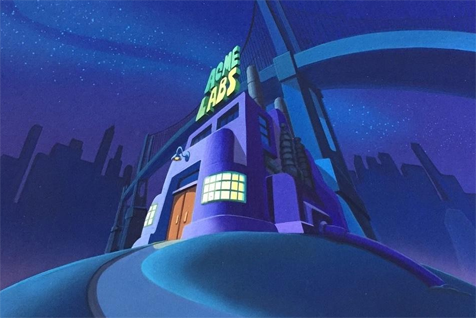
Now that we’re done with that long cameo, it’s time for our feature presentation for tonight, and it’s a doozy!:


We open with Pinky frantically running on a spinning globe while Brain stands above him on the…globe holder? I don’t know if that part has a name or not.
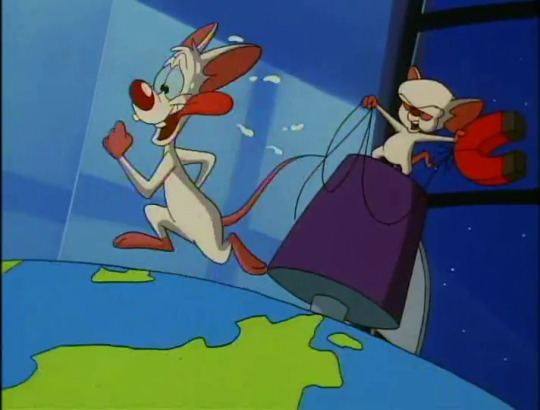
“[winded gasps] Can I stop now, Brain?”
“Not until I finish my demonstration.”
Brain, that’s just… Well I was about to say it was mean, but given that Pinky understands the details of his plans better when Brain demonstrates it or draws elaborate diagrams, maybe it’s for the best? I doubt Brain could make that large globe spin just by using his hands, and Pinky’s been seen a lot of times running on the mouse wheel in their cage so he’s gotta be pretty in shape. Still, it feels like Pinky’s been running for a lot longer than he needed to…
You know what? I change my mind. It is a bit mean, Brain.
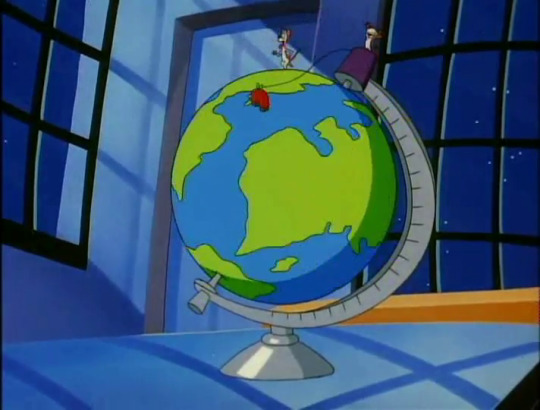
“When I build my reverse geotropic arrestor, Pinky, and throw it from the North Pole like this…”
The word “geotropic” doesn’t quite sound right. I wonder…
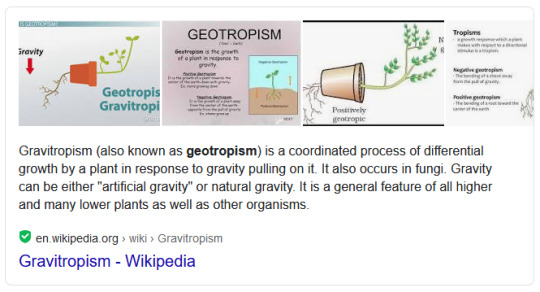
…Okay, yeah, Brain’s getting worse at naming things.

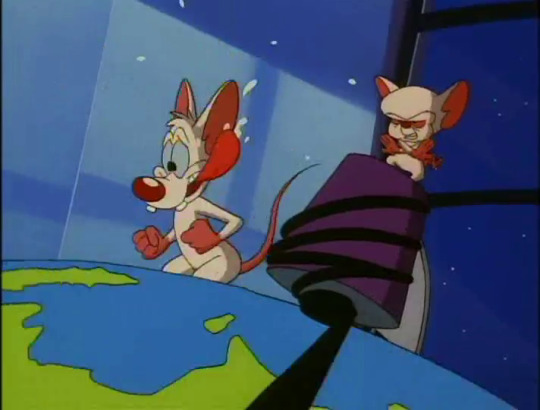
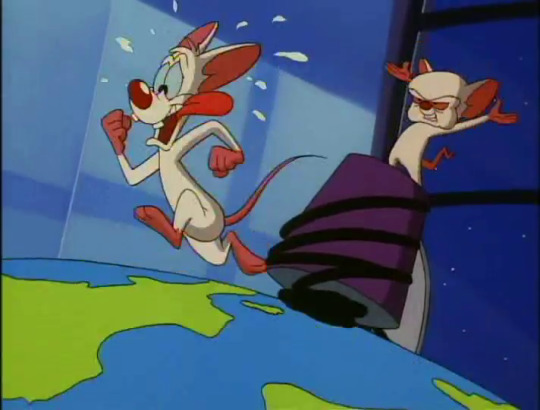
“…In a matter of seconds the cable will become taut, gravity will cease, and everyone will fly off the face of the Earth!”
Oh my GOD, Brain. This has got to be the stupidest plan you have come up with yet! Nothing about this will work.

Well, there goes poor Pinky.

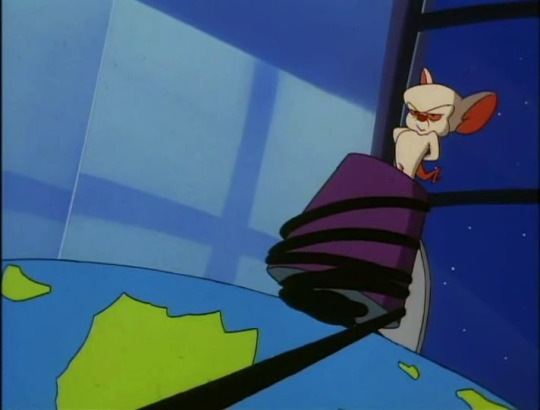
“Leaving us alone to assume control.”
It’s still “us”, huh? Noted.
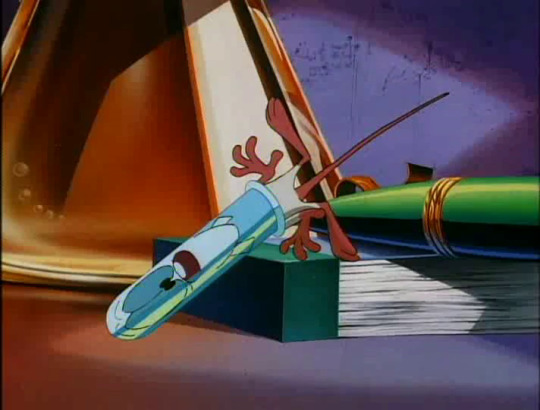

Long Pinky.

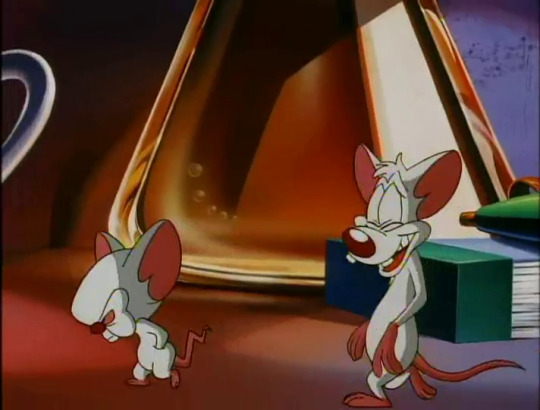
“Egad, Brain, brilliant! Haha hehe heh—!”
Pinky, sweetheart, I know praising Brain is kind of your thing but this is one time I’m going to have to call you out on your bias because this is super not brilliant and I’m actually a little worried for Brain’s mental state.
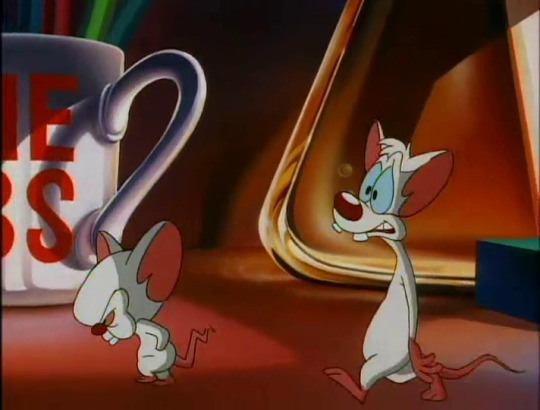
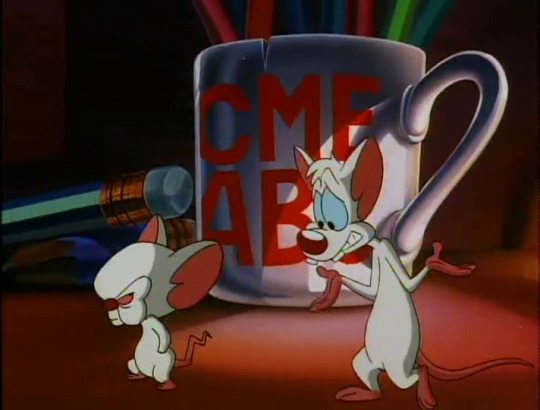
“—Oh wait, no, no. What’s going to keep us from flying off the Earth?”
That’s one flaw of many, Pinky, but I guess it’s as good a start as any.
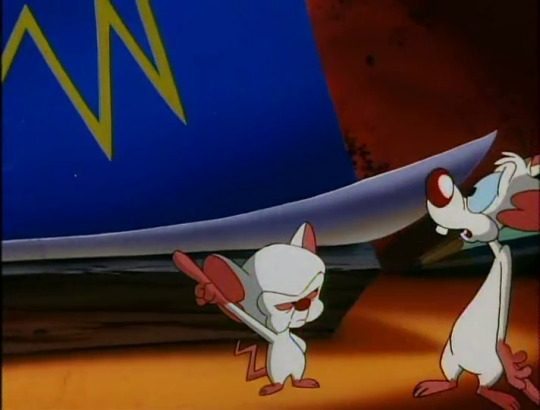
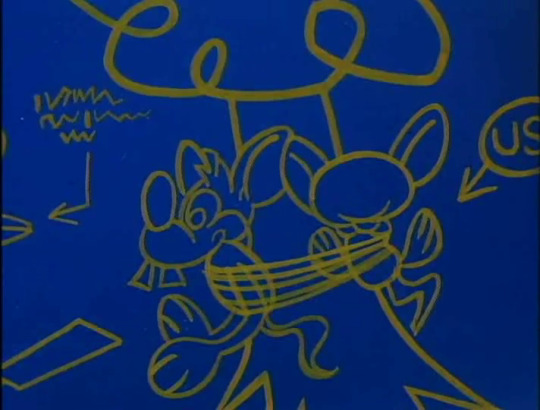
“We will duct tape ourselves to a tree.”
Because the tree will totally stay in the ground when the Earth abruptly stops spinning. Not that it will stop spinning, because none of this makes any sense.
Brain, did this idea come from, like, a dream you had or something? Is that why the plan is working on dream logic?
I know this is a comedy cartoon and this is all a joke but sometimes Brain’s plans are so fucking out-there I just have to roast him for it.


“Unfortunately we still need to raise money to buy a one billion ton magnet. But I have a solution!”
Oh boy, can’t wait to hear the solution to this one. It’s gonna be stellar if the whole plan today is anything to go by.
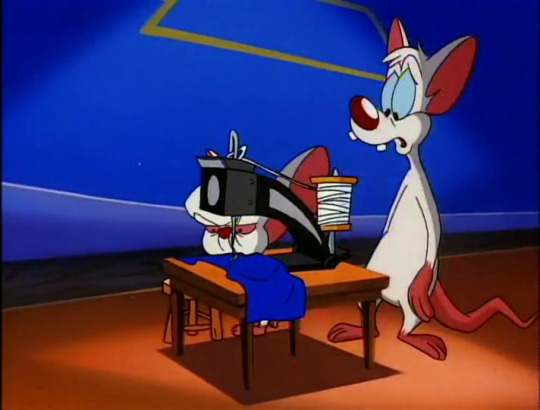

Oh nice, Brain’s the one sewing for a change! Usually this is Pinky’s area of expertise, but it’s always nice to see that Brain can do some classically domestic things too.
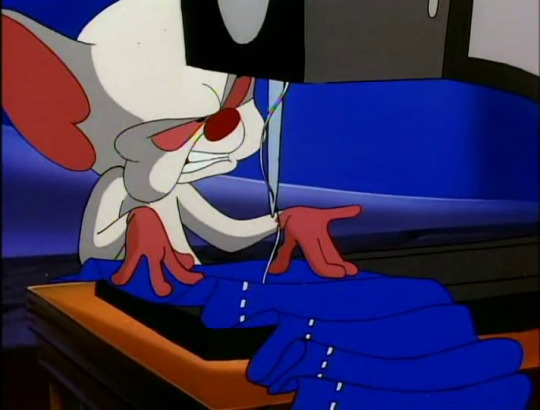
“Tomorrow is the running of the Kentucky Derby. Do you know what that is?”
Most of my knowledge on it comes from “My Brother, My Brother, and Me” goofs, so my mind keeps autocorrecting it to “Kenfucky Derby”, but go on.
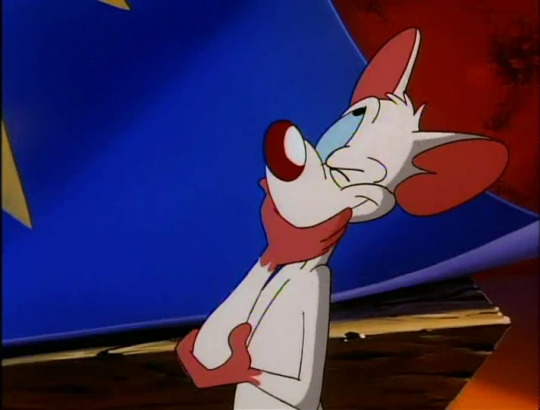

“Umm… Oh! A very large hat?”
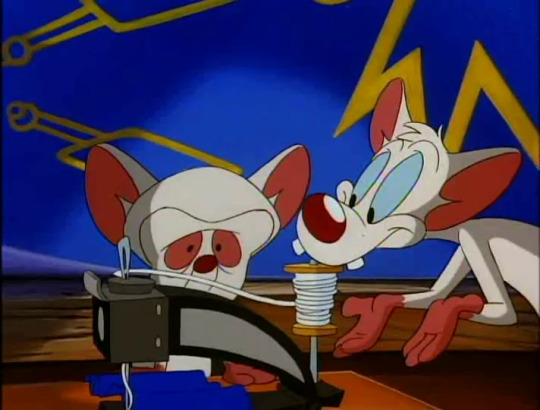
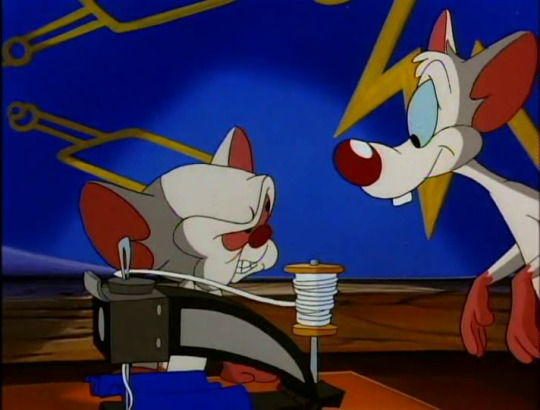
“Promise me something, Pinky. Never breed.”
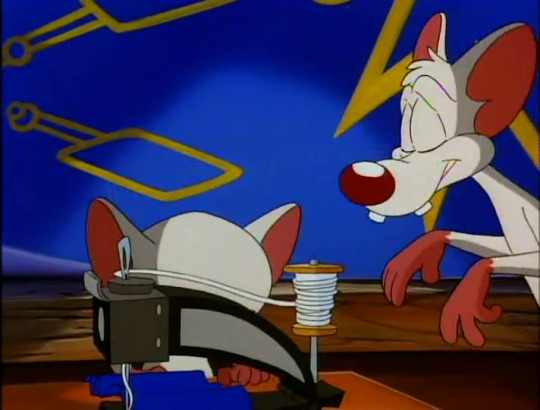
“I’ll try.”
Well, that’s going to come back to haunt them.
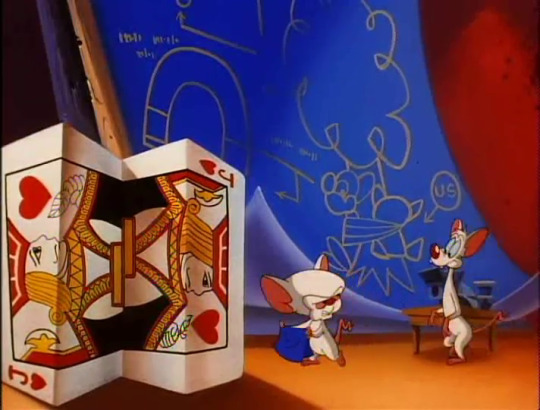
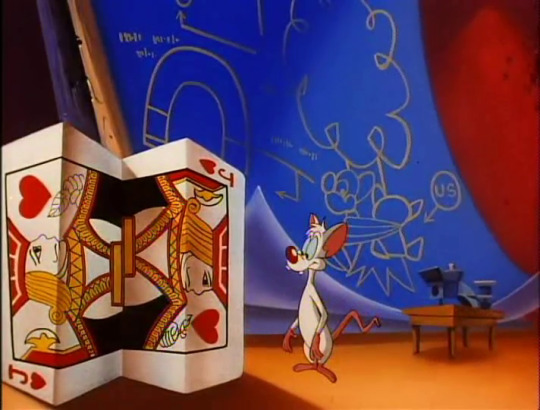
“The Kentucky Derby is the biggest horse race of the year. There’s a one million dollar purse going to the jockey riding the winning horse.”
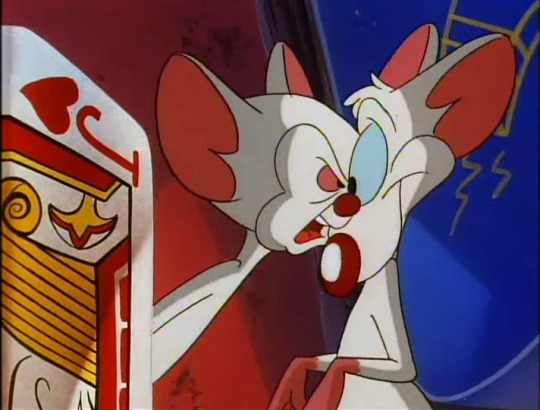
“And I am going to win that purse!”
Okay, first off: Pinky, are you just going to stand there and stare at Brain as he gets changed? Like, I understand they’re naked normally and this is the exact opposite of stripping but umm…
Secondly: Brain, did you really have to get that up close to tell Pinky this? You two are making this too easy for me.
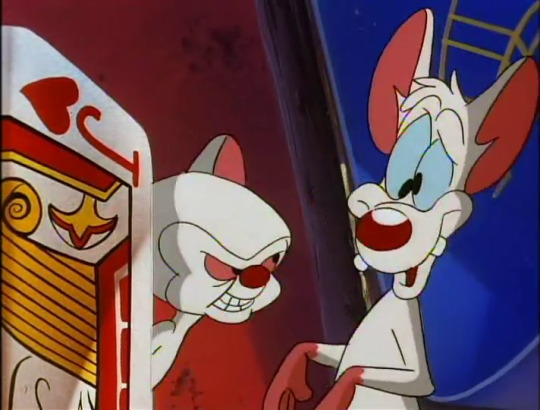
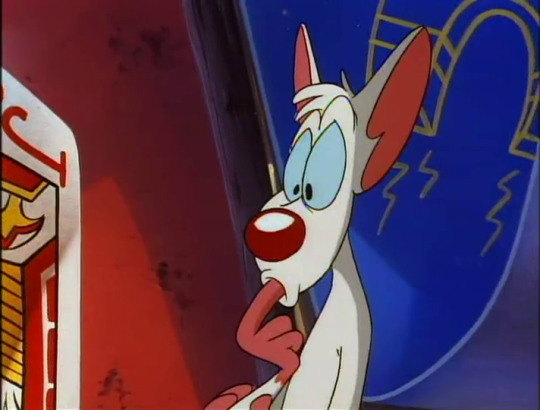
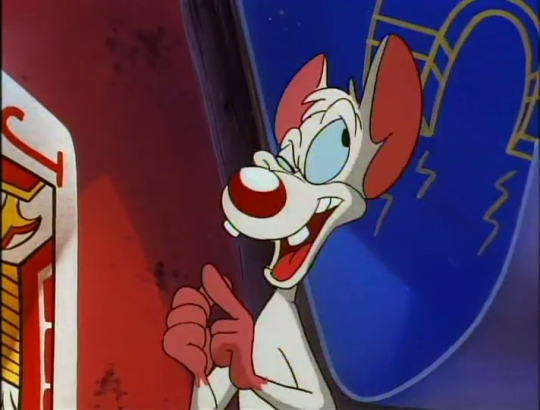

“Zort, Brain! A million dollar purse?!? Ooooh!~ You’re going to need matching pumps and earrings for that!”
Pinky’s got his priorities in order.
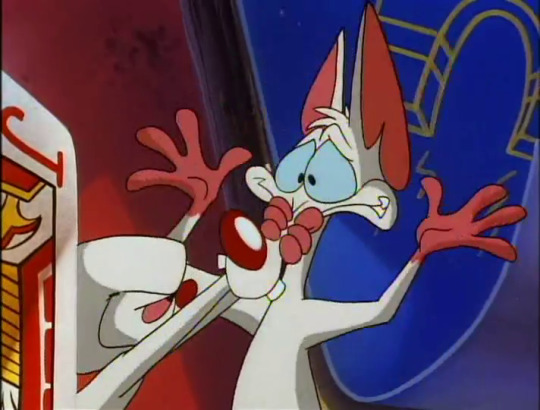

“Focus, Pinky, focus!”


“Now watch.”
And now Brain’s ordering Pinky to watch him dress and I just…I have no words. This is all so suspect. Why do you two even need a dressing screen if you’re usually naked anyway? And it shouldn’t matter if anyone sees you get dressed unless this is some weird reverse nudity taboo you two have developed and if that’s the case, why are you allowing Pinky to watch? And if it’s for a dramatic reveal WHY ARE YOU ORDERING HIM TO WATCH YOU CHANGE???
This episode is already so goddamn wild.
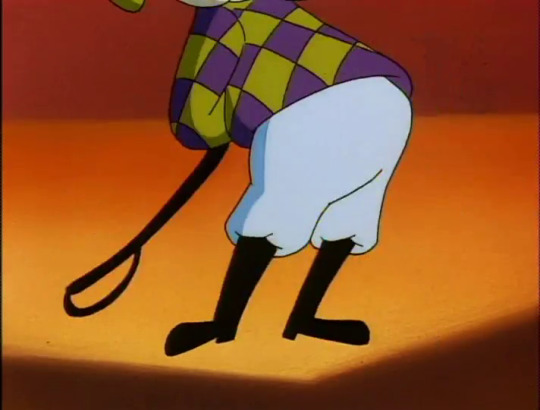
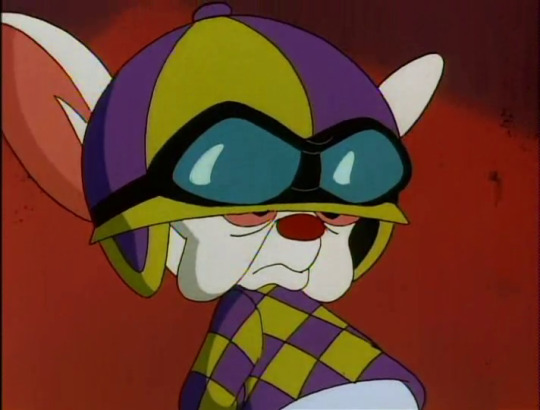
I am really not sure how I feel about that pan-up of Brain when he’s thrust his pelvis forward. At least the outfit is cute, though.
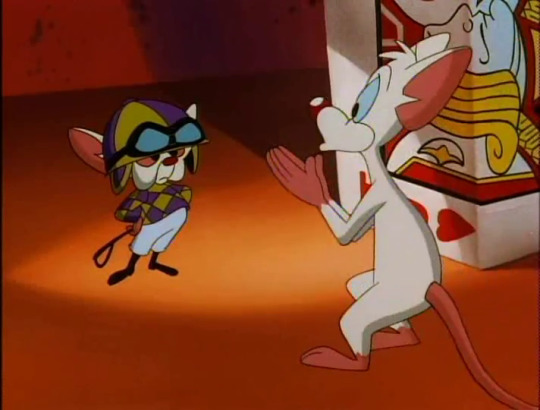
“Narf! Oh, Brain, I get it! You’re a beautiful lawn ornament!”
“Beautiful”, huh? Also noted.


“Look at me, narf, I’m a pink flamingo! Ahahaheh!”
Oh LORD, Pinky, how are you—?!?

“I’m a cement deer! Ah hah!”
PINKY, STOP, YOU’RE SCARING ME! D:

“Oh, I’m one of the seven dwarves, Brain!”
That’s more acceptable but Pinky, sweetie, warn me if you’re going to nightmarishly shapeshift again, okay?!
I guess we can add that to the list of random abilities Pinky has.
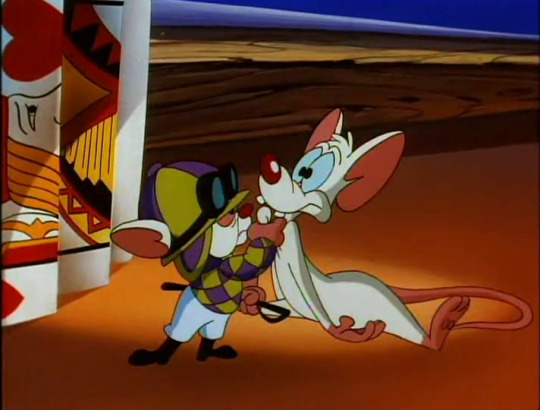
“Stop it, Pinky, or I shall have to hurt you.”
You are much calmer about this than I would be if this happened in front of me, Brain.
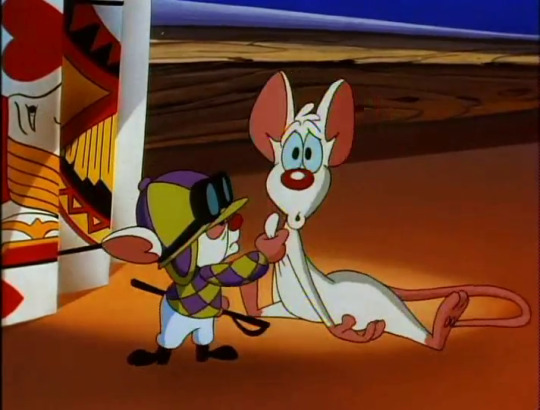
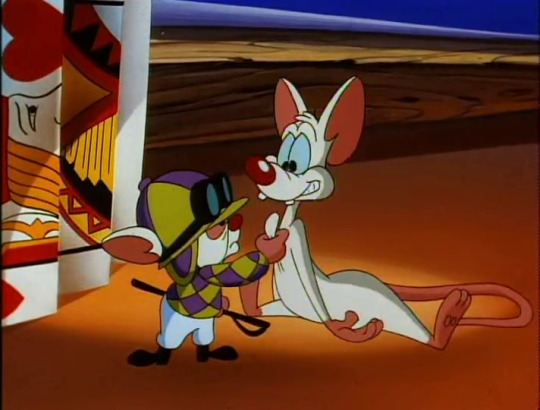
“Oh. Right-o, Brain. Narf.”

“Now let us make haste, for we have much to do before the race begins.”
“Poit.”
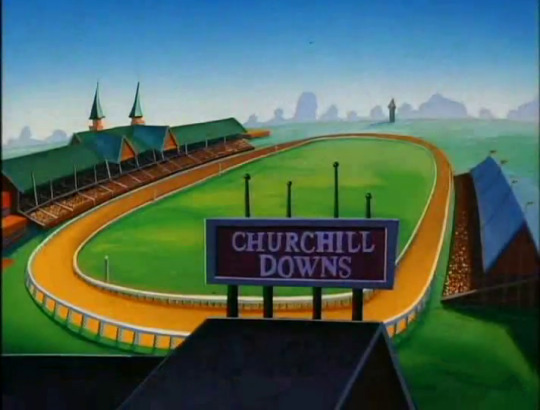
So then we cut to Churchill Downs, and I can only assume another roadtrip adventure was had off-screen.
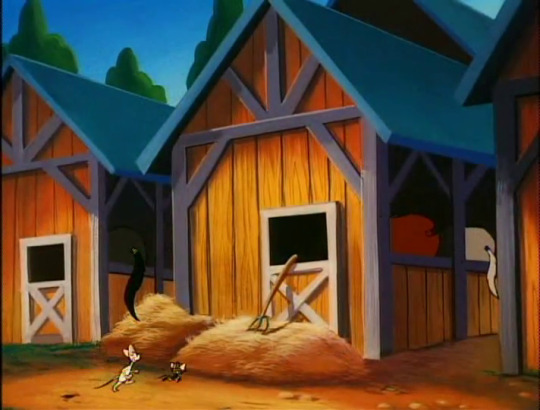
“First, Pinky, we must visit the stables.”
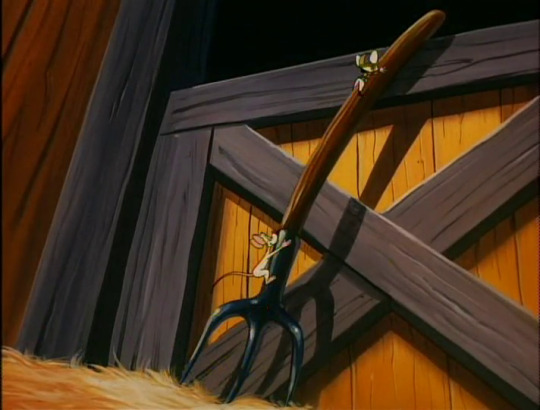
“Inside, we will find the winning horse.”
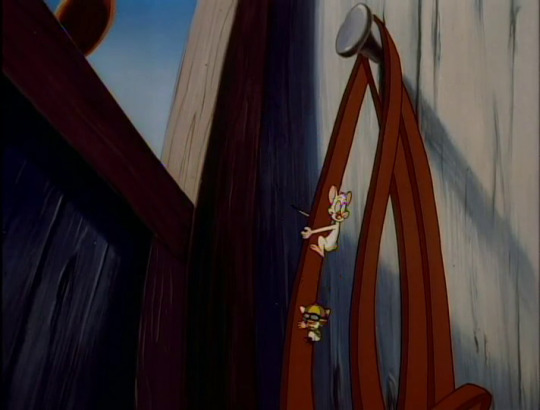
“Err… How are we gonna do that, Brain?”
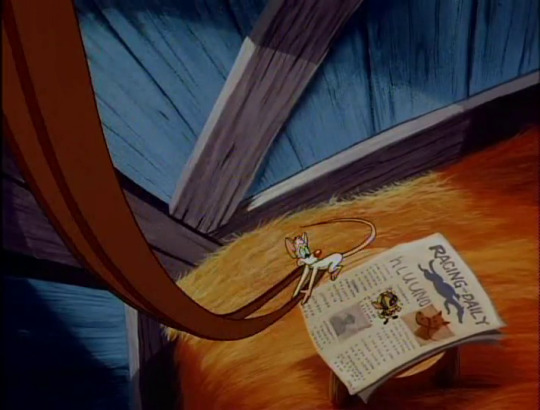
“The racing form, Pinky.”
My bet’s on... [squints] hLUUNO the horse.
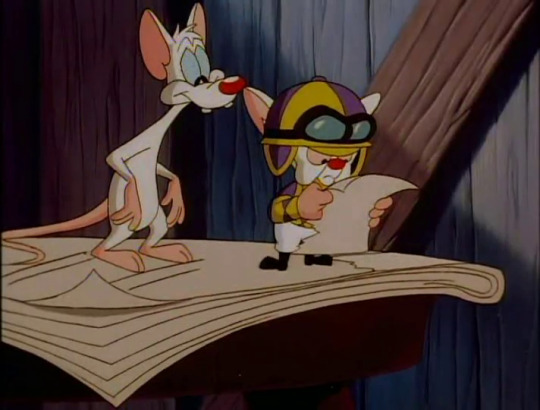
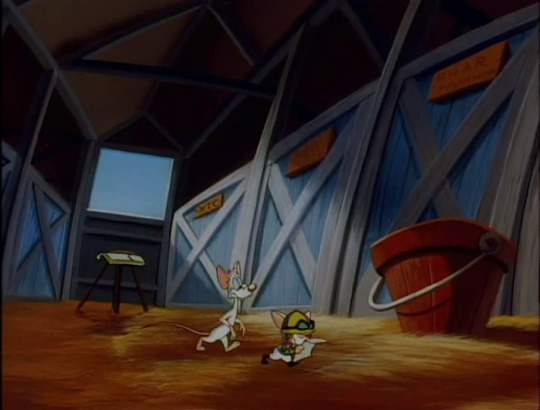

“By analysing the velocity-based pace line, mile turf win and bayer speed figures, we’ll find a grade one stakes claimer who’ll give us a key horse situation.”
“Key Horse Situation” would be a great band name. Also, whoops, little bit of an error on the name plaques, background artists.
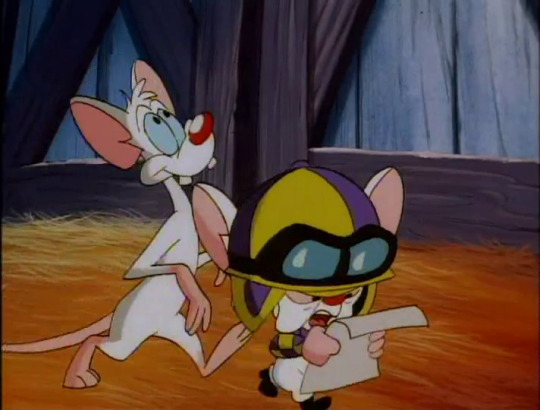
What do your mouse eyes see, Pinky?
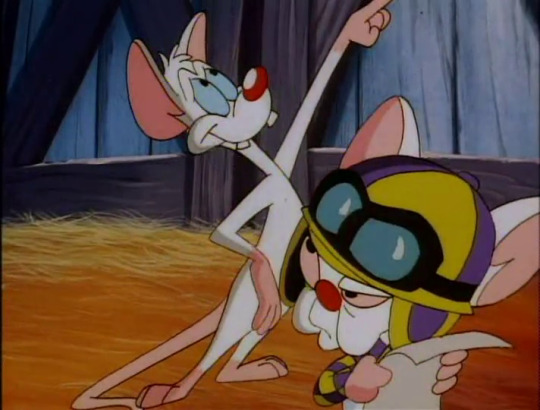
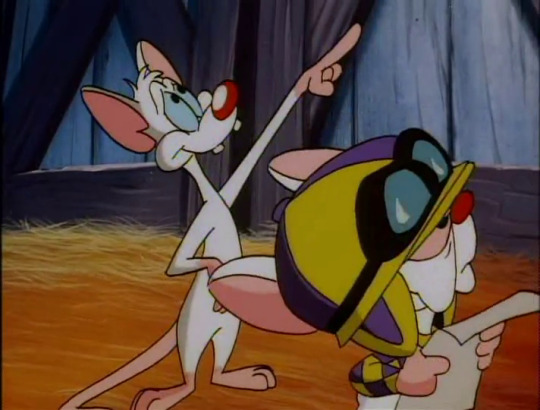
“Err, can’t we just ride the pretty one?”
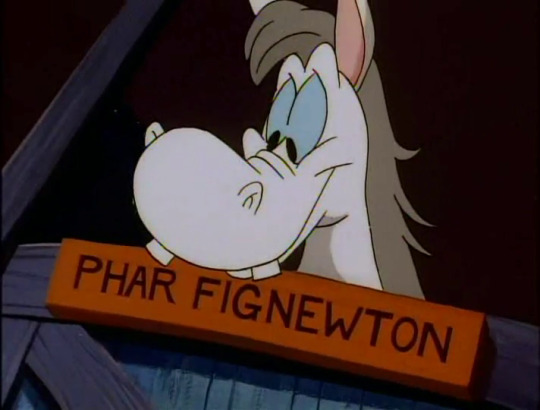
SHE!
So here she is, one of the few characters debuting in the Animaniacs run that will matter to PatB lore going forward aside from our main duo.
A fun fact for you all: Phar Fignewton’s name is a triple reference joke. “Phar Lap” was a champion thoroughbred race horse in the late 1920s and early 1930s. Fig Newtons are small pastries filled with fig paste. Lastly, “Fahrvergnügen” was a slogan for Volkswagon starting in 1990. Translated, it means “driving enjoyment”.
Phar Fignewton makes a whinnying noise and ends it off with a goofy laugh.
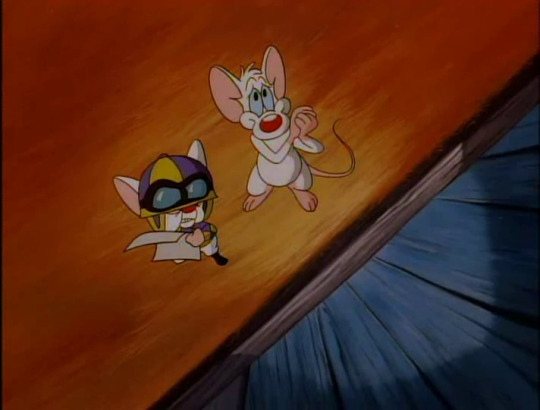
Brain is not impressed.
“Heavens, they’re multiplying…”
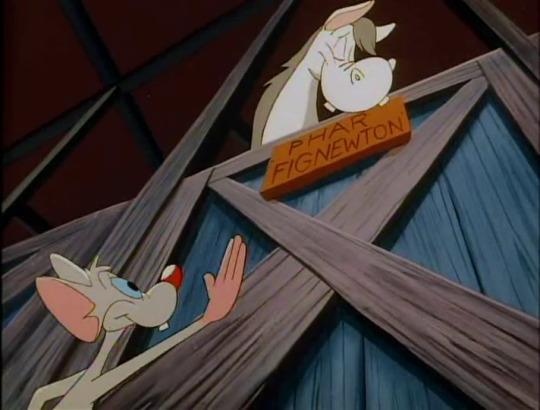
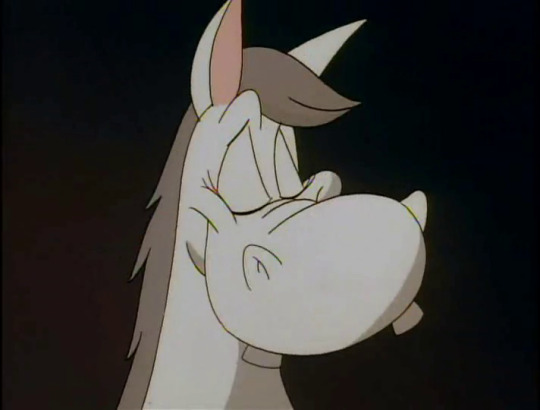
Pinky is instantly smitten with her.
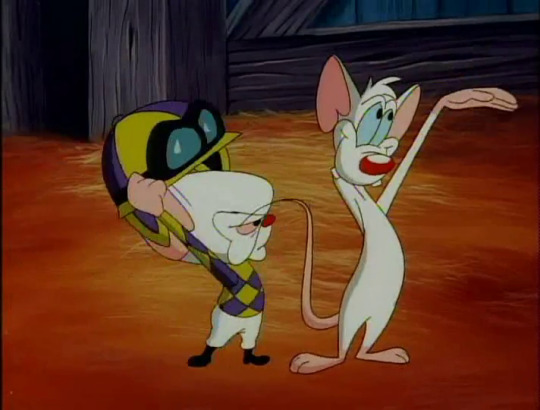

BONK!

“This is a business trip, Pinky!”
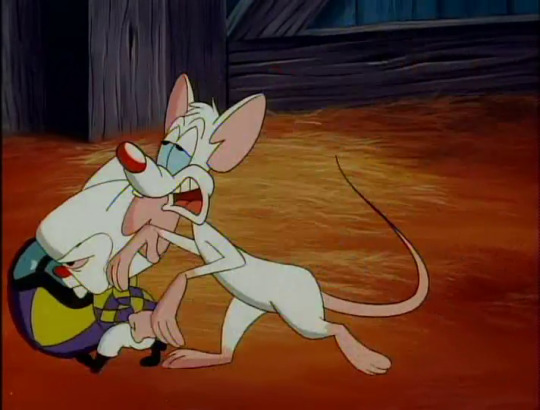
“Oh. Right. Sorry, Brain.”
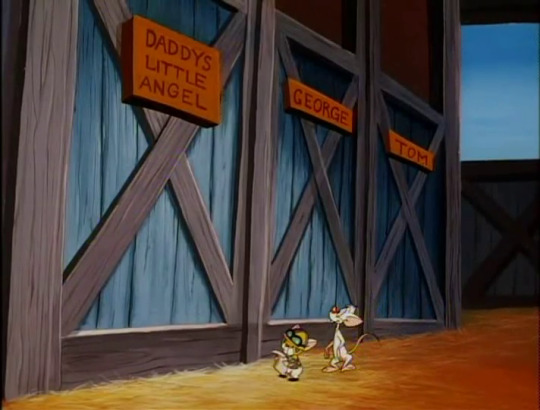
“Here is our horse.”
“’Daddy’s Little Angel’…”
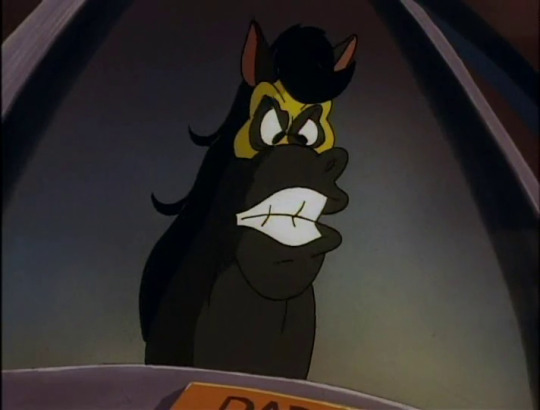
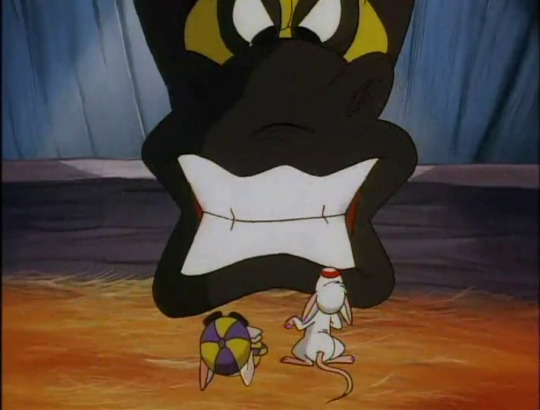
I guess it’s an ironic nickname.

“Pinky… Are you pondering what I’m pondering?”

“Whu… I think so, Brain, isn’t Regis Philbin already married?”
…
Now I’m wondering if Pinky is suggesting that one of them marry Regis or if he’s suggesting that Regis marries the horse. Either way, what the fuck?

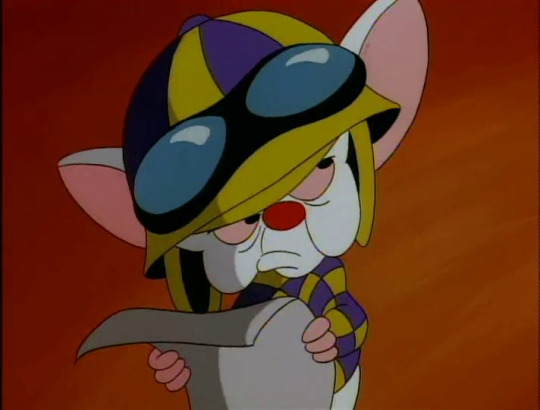
Yeah, same.

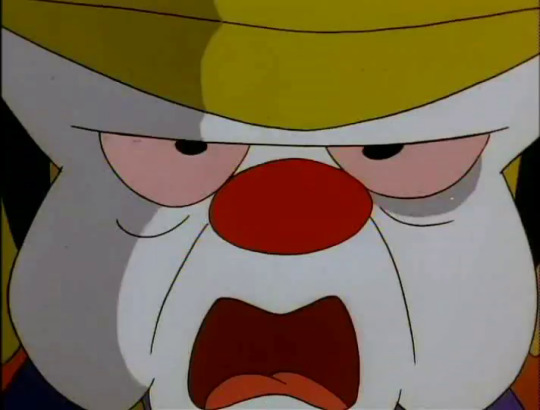
“The race, Pinky. By combining the statistics and my low body weight, this horse cannot lose! The prize money will be ours!”
GAH! Brain, I’ve had enough minor heart attacks from this episode because of Pinky’s eldritch morphing ability, I don’t need another one of your bizarre close-ups to do the same!
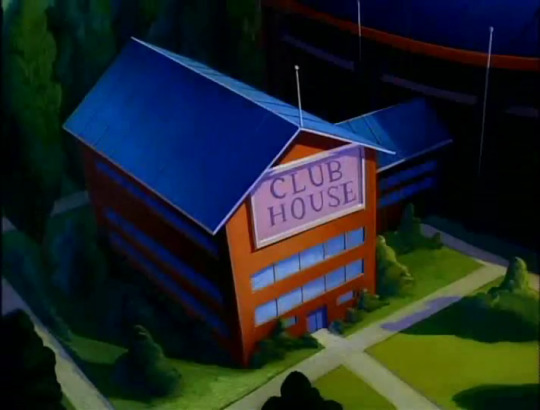
“Now I must take the place of the real jockey.”
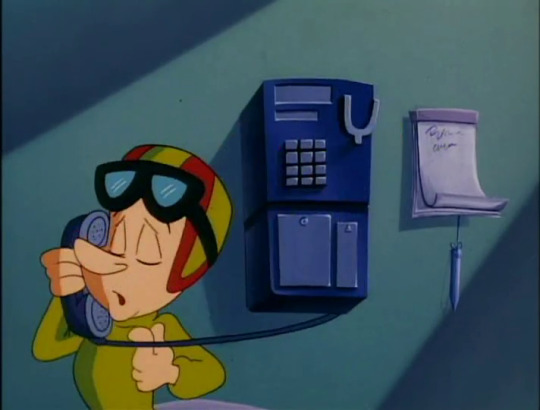
“Hello?”
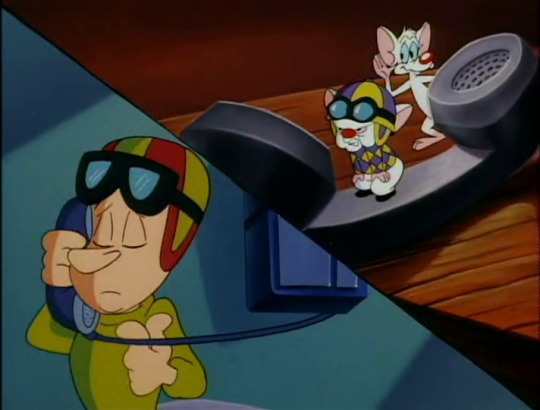
“Is this the Jockey who’s going to ride ‘Daddy’s Little Angel’?”

“Yeah.”

“This is Ed Mcmahon from Publisher’s Smearing House. You’ve just won ten million dollars.”
Pinky delightedly and silently listening in and chuckling in the back is precious.
And honestly, Brain, I don’t know why you’re crouching here, but it’s also cute.
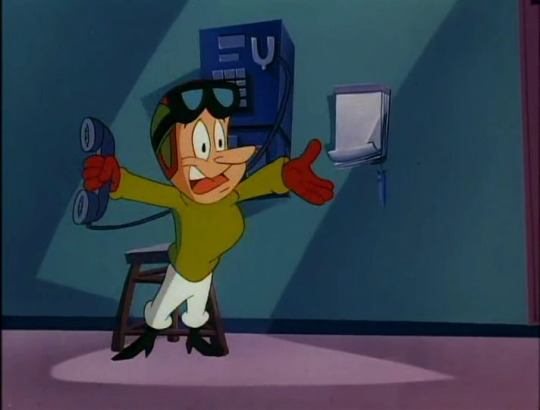
“I won ten million dollars… I WON TEN MILLION DOLLARS! I am outta here! Later!”
The mice are lucky that he’s so excited about winning all that money that he forgets to do basic things like ask when and how he’ll get the money.
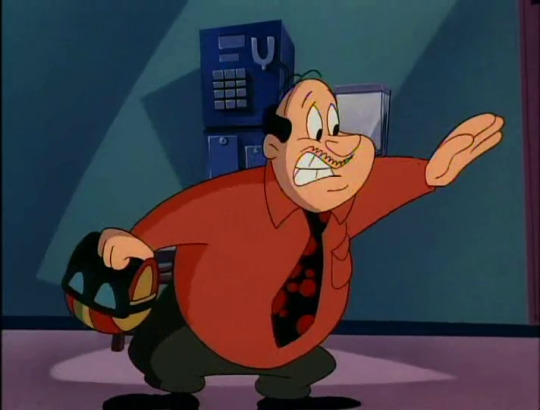
“Louie! Louie!”
“Later!”

“Who’s gonna ride my horse? I mean, Louie is the smallest, lightest jockey in the entire world!”
Did you know that there’s a weight requirement for jockeys, but no height requirement?
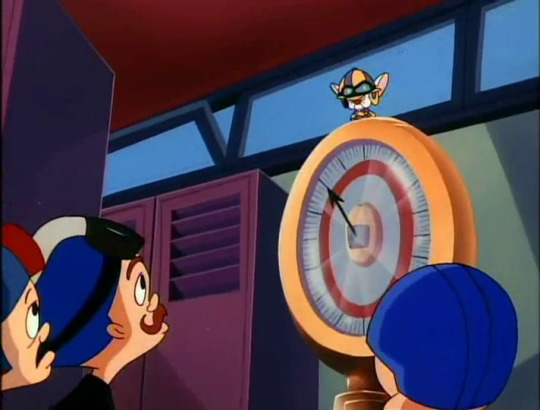
“Not anymore!”
“[GASP]”
Whoops, I just noticed another error, though it’s minor: Brain’s jockey outfit throughout this scene is light tan and purple instead of the pea green and purple that it’s supposed to be.
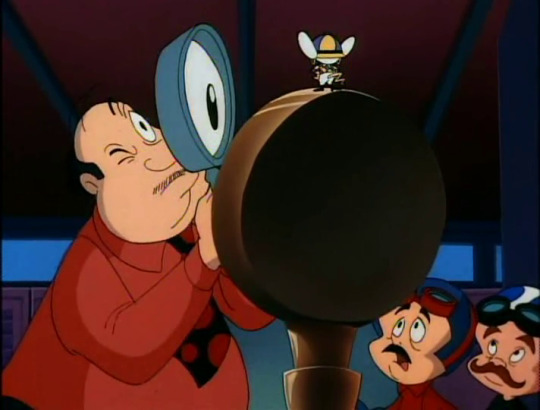
“You’re a jockey?!”
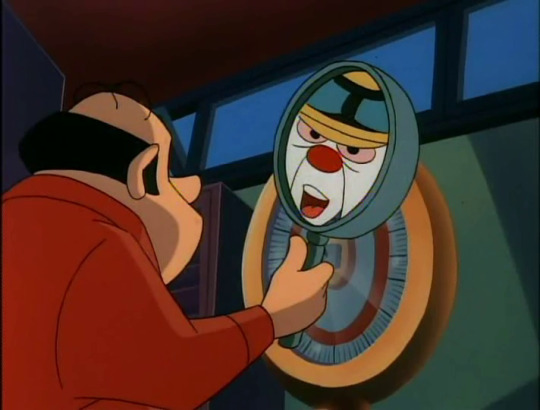
“Actually, I am a mouse in the early stages of an elaborate scheme to take over the world.”
The more this happens, the more I’m starting to think that Brain does this shtick on purpose to emotionally and mentally disarm people who would otherwise suspect that he’s not human. The fact that it works shows you just how idiotic the human beings of this world are.
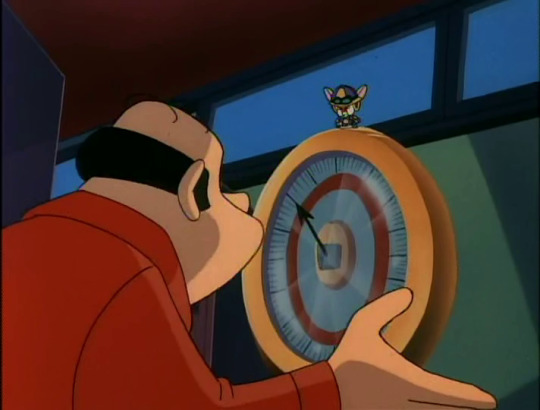
“Well, fine, we all need a hobby but…will you ride my horse?”
Oh, sir, I think it’s much more than a hobby at this point. If only you knew…

“I shall ride! And win!”
His design is a little odd here, but it’s still a good pose.
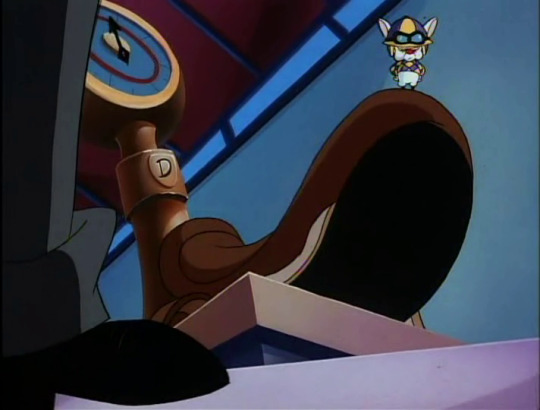
So Brain next has to be weighed to make sure he meets the requirements.
“Saddle: Seven pounds. Saddle and rider: Seven pounds 3 ounces.”
So if you can recall from the previous rewatch post, a house mouse on average weighs 19g, and a common wood mouse weighs 23g (it can be up for debate which type of mouse Brain is). Converting Brain’s 3 ounces of weight to grams would result in him weighing 85.0486g.
Brain does have a bit of a cute little potbelly thing going on, but he’s also consistently much smaller in height and width than the average adult mouse in the series. I think the incredible difference in weight is mostly coming from the heft of Brain’s, well, brain and skull…and the muscle mass packed into that tiny body to help keep him upright.
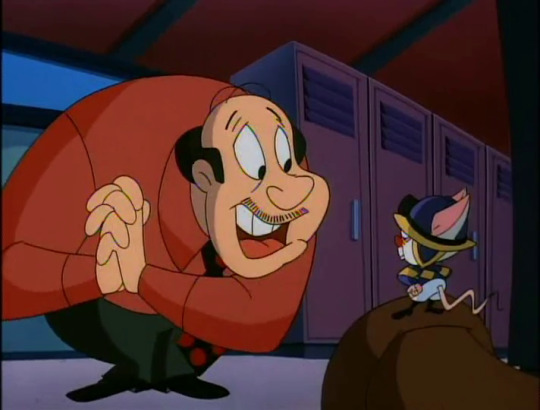
“A genetically perfect jockey! This is fantastic!”
Please don’t phrase it like that.
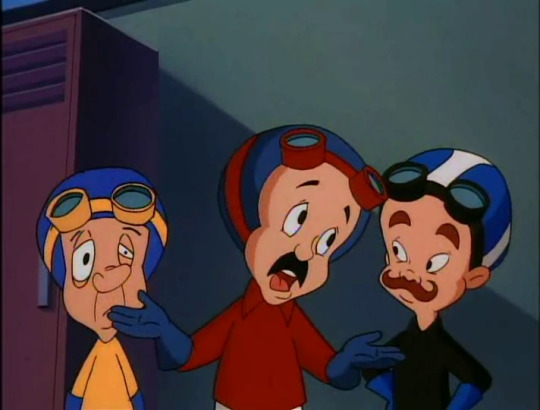
“…Let’s look into early retirement.”
That jockey on the left is going through some shit, man. He looks like how I feel after working an eight hour shift on the holidays.
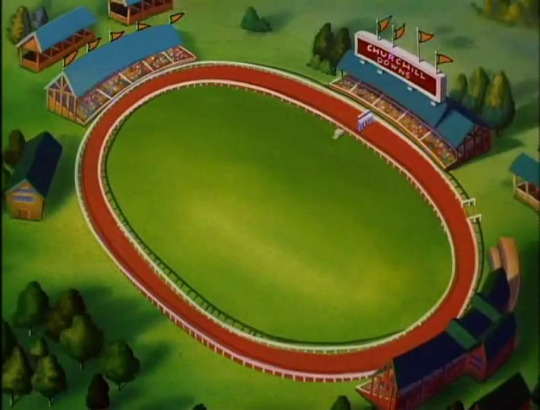
And so we skip to the beginning of the race!

That poor, poor jockey…who changed colour schemes for some reason.
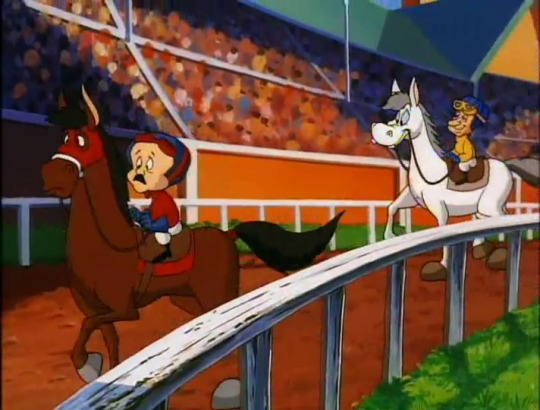
There’s Phar Fignewton with a jockey who honestly looks like he’s high.
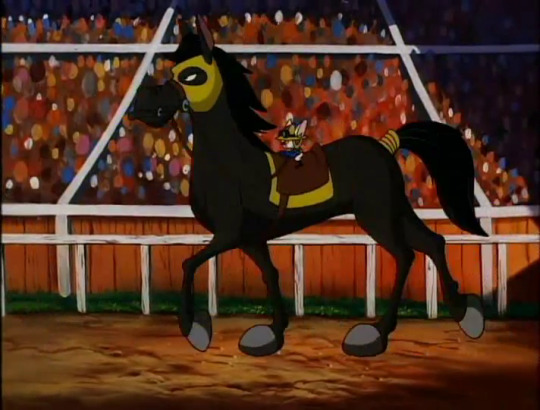
And here’s our little mousey fella, who has somehow managed to make this aggressive horse obedient.

“Camptown race is five miles long, do-dah, do-dah.~”
He’s so happy he’s singing to himself! This is honestly so precious that I completely forgive him for not getting the lyrics correct.

Coincidentally, Daddy’s Little Angel is positioned next to Phar Fignewton.
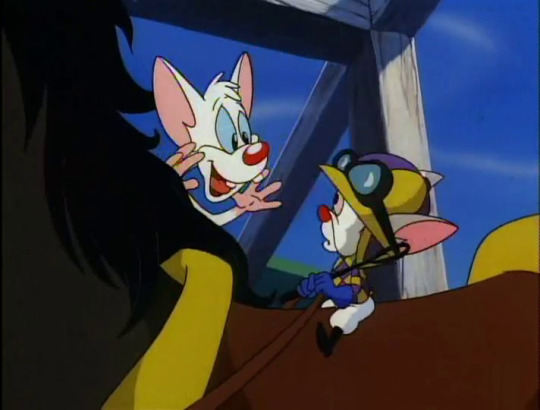
“Ooh, isn’t this exciting, Brain?”
Uh oh.
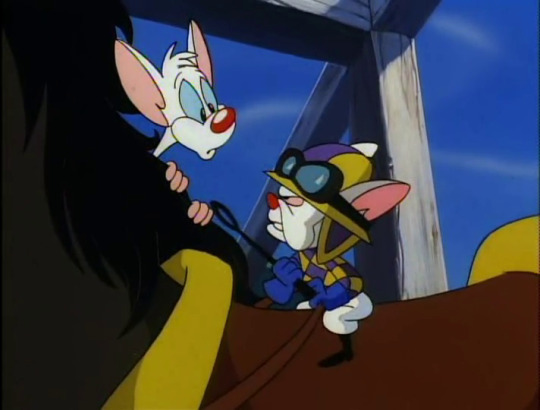
“Pinky, what are you doing here? Your weight will disrupt my winning calculations!”
I don’t know if it’d be that off, Brain. The combined weight of two mice is still much less than that of a human jockey.
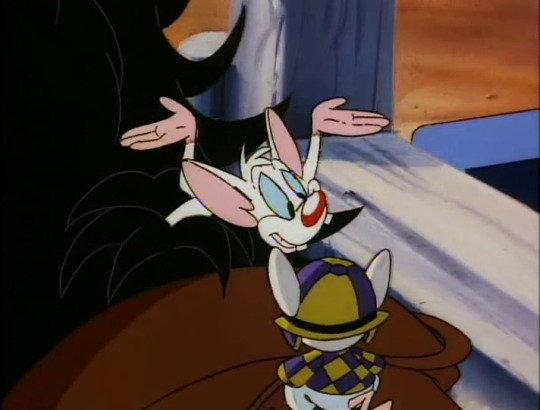
“But Brain, it’s too exciting! I—“

[TARGET LOCKED]

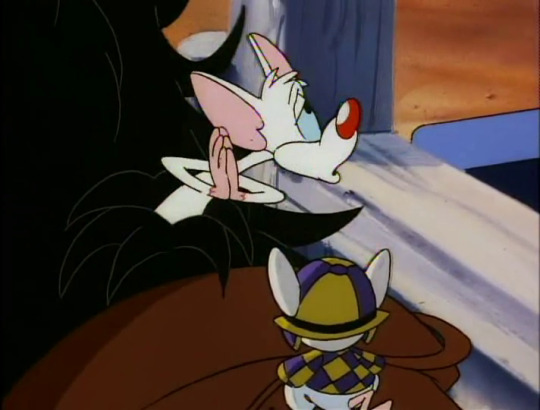
“Oooh! Heh. Hello.~”
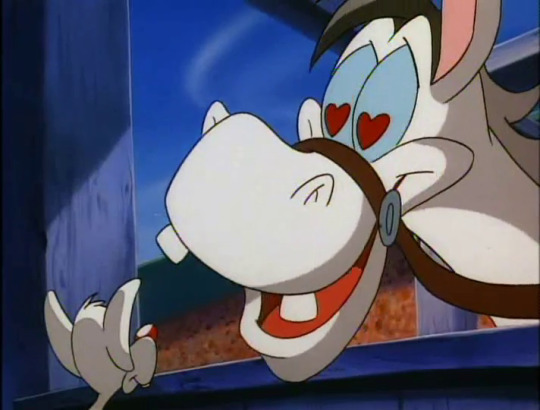

I think I’m going to save my thoughts on this whole…thing until the end. Right now I will say, however, that I wasn’t quite expecting the tongue-hanging-out-of-gaping-mouth lovestruck/horny??? reaction.
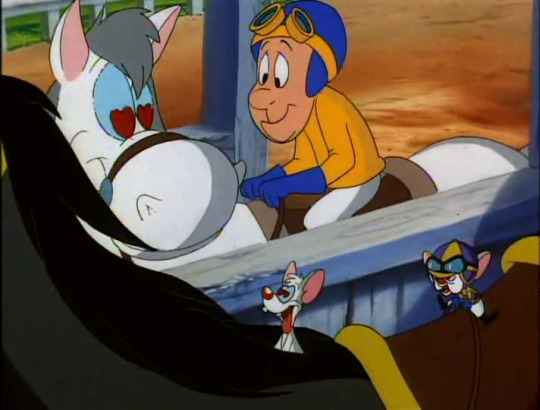
“Pinky, the race is starting!”
Too late, Brain.

And we’re off!
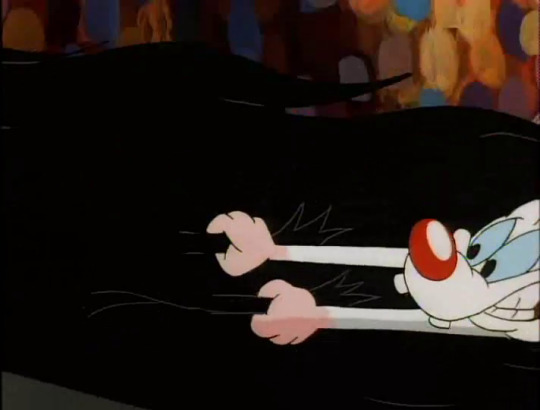
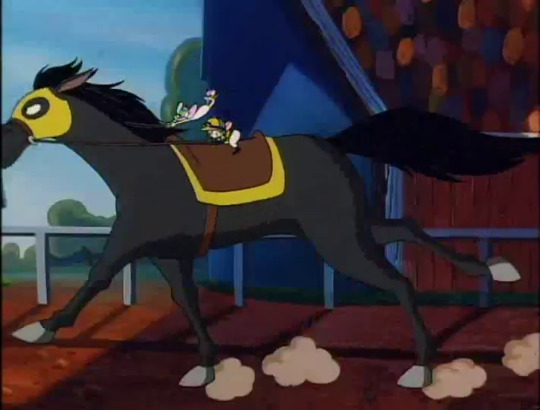

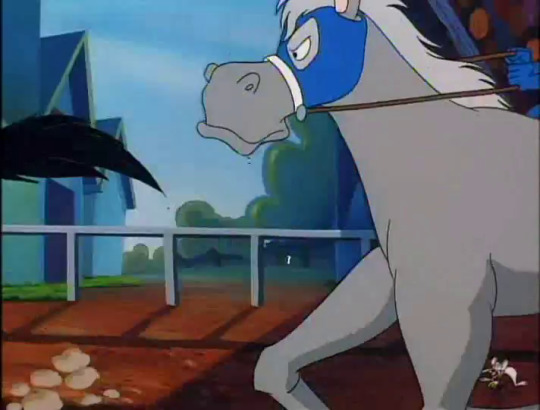
Bye, Pinky.

“There’s baloney in our slacks…~”
Pfft.

So as the race goes on, we get to know a few more of the horses’ names: Isle of Yap (a nice callback to the first PatB short), Flamiel (which is apparently the WB writers’ favourite word?), and Leggo-my-Egoiste (a double reference to an old Eggo slogan and the name of a cologne).
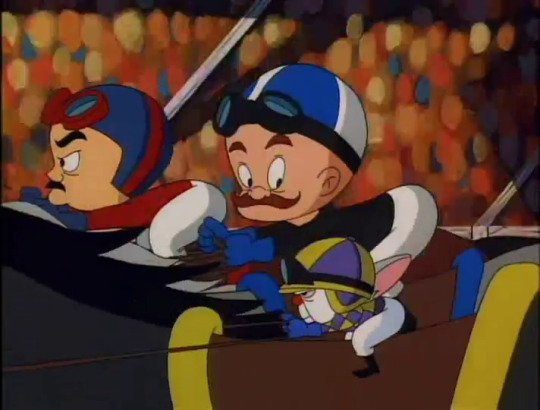
The other jockeys are more than a little surprised by Brain and his steed taking the lead early in the race.

Phar Fignewton is trailing way behind.

Meanwhile, Pinky’s woken up from fainting, seeing the oncoming horses—
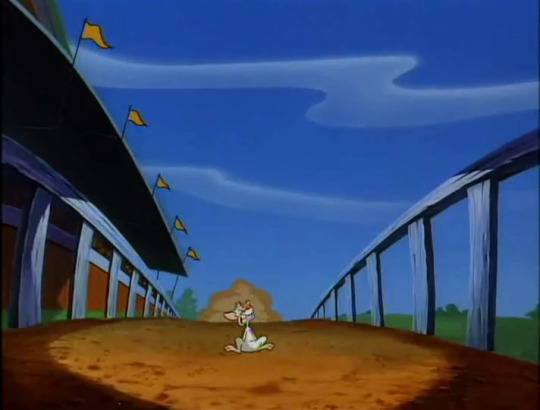
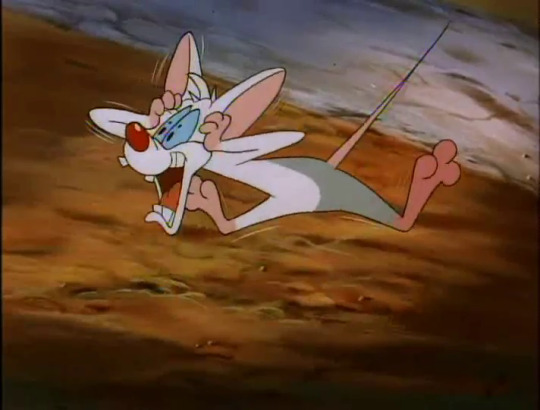

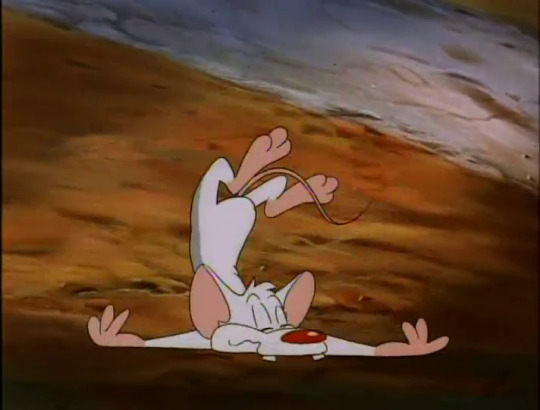
--and promptly freaks out and stumbles back down again.
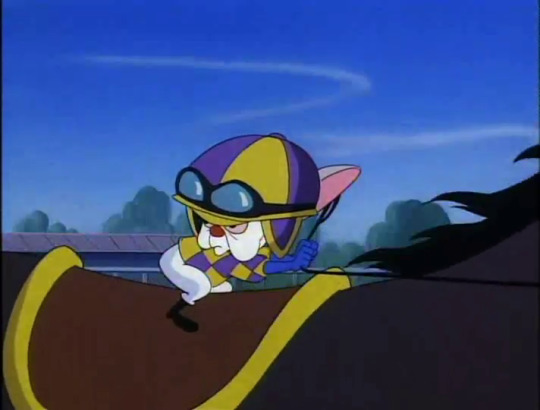
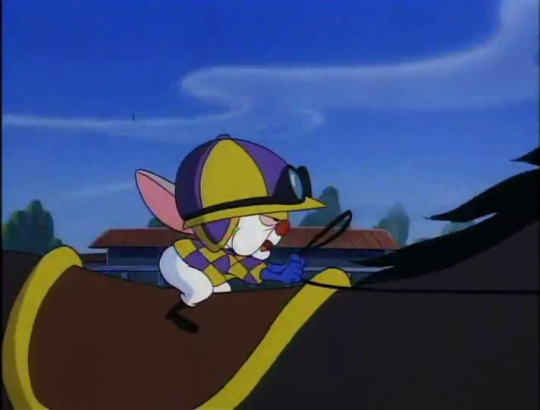
“Victory, she waits for me! Oh, the do-dah-day!”
You really have to stop tempting fate like this, Brain.
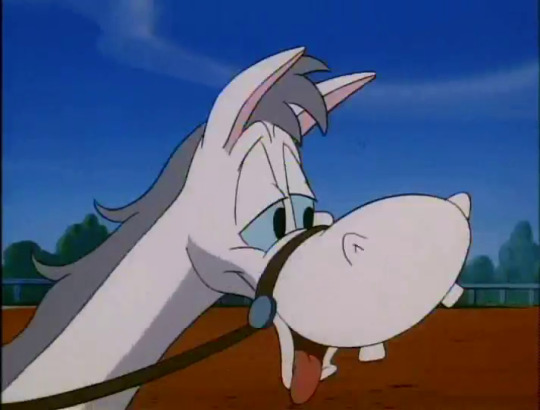

Phar Fignewton’s very tired, but what’s this?
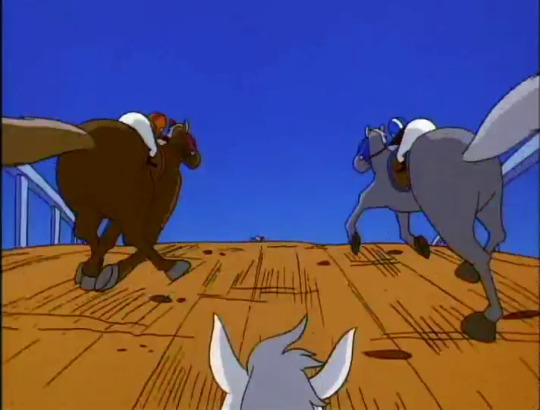

Is that…Pinky in harm’s way?
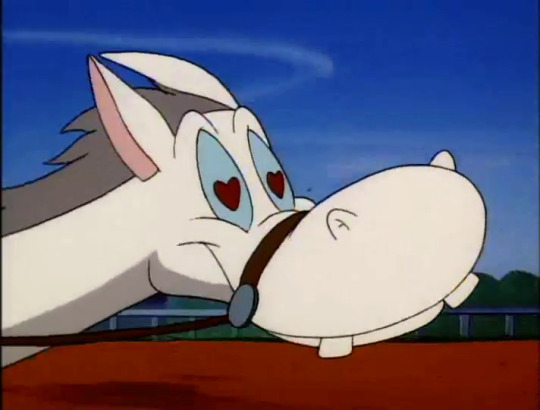

ThePowerOfLove.mp3
Determined and fueled by her inexplicable crush, Phar Fignewton starts gaining ground on the other horses.
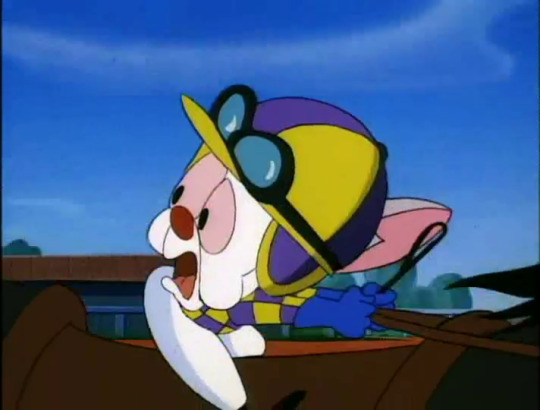
Brain didn’t calculate for this!
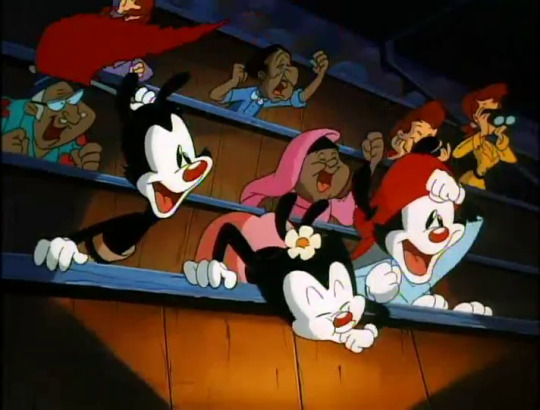
…Oh! Hi, Warners! Looks like they’re cheering Phar on.

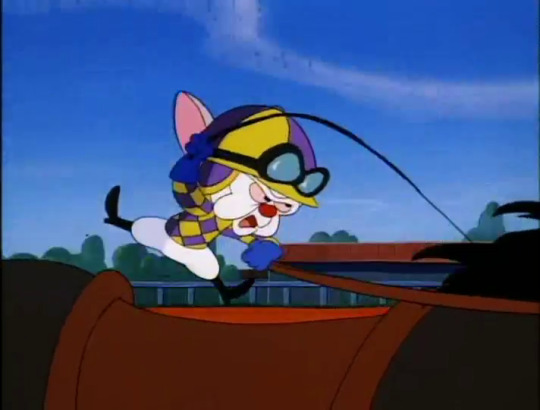
“Oh no! Yah! Yah! Yah!”
I didn’t think whips were allowed in races like the Kentucky Derby, but apparently they are. Their use was only restricted—not banned—in the summer of 2020, which is alarming to say the least.
On a different note, I know some of you folks are now jotting down the fact that Brain knows how to use a whip. I see you.
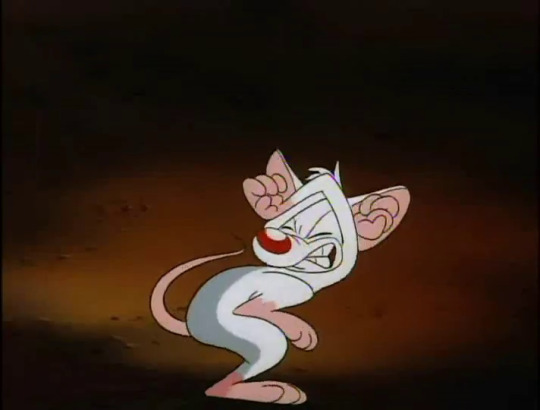
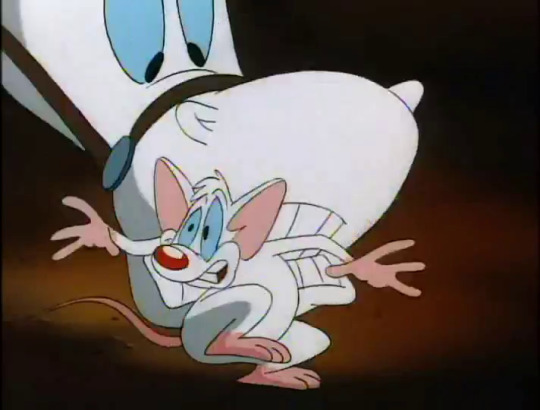

She makes the save!

And she also wins the race! Way to go, Phar Fignewton!

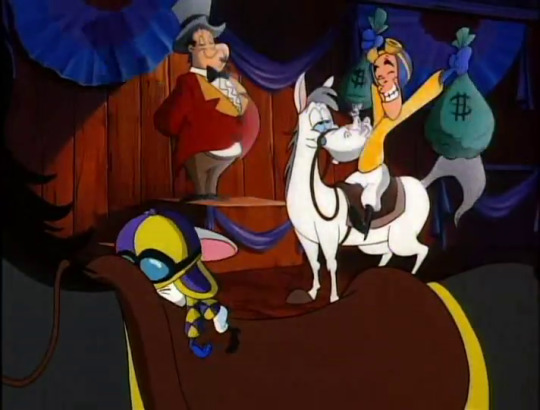
“In the words of the great Willie Shoemaker: ‘Nuts!’”
It was a good try, Brain, but honestly I’m glad you failed this time if only so that you wouldn’t embarrass yourself with your actual world domination plan’s failure later. Maybe take a couple nights off to rest up a bit and formulate plans that aren’t totally bonkers, hmm?

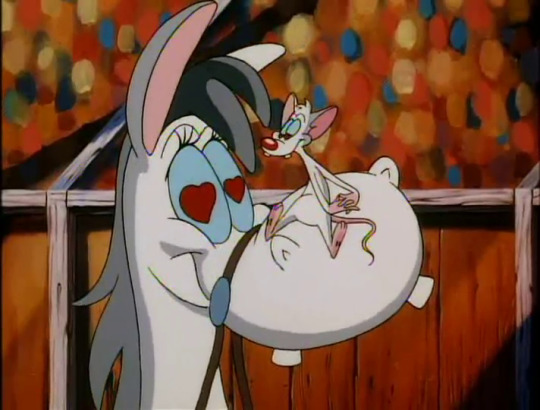
I might as well go ahead and talk about this now. I…am conflicted on this whole Phar Fignewton thing. It makes for a very strange one-off joke about Pinky instantly falling in love with a distaff counterpart of his that’s a horse for whatever reason…but the fact that she’s not a one-off character is baffling in and of itself. Like I’ve said before, she’s mentioned a couple of times going forward as being Pinky’s girlfriend, or as a bizarre joke at Pinky’s expense about him being in/having been in a relationship with a horse. There’s even a small running gag about Pinky’s reaction to people’s disgust about it: “People can be so intolerant!”. I don’t know if the joke is supposed to be one about racial segregation or a wink and nod to queer folks in the only way that the writers could get away with in a cartoon at the time (in a “see, Pinky’s down for a relationship with anyone, even outside of his species!” type of way).
Phar Fignewton herself is a sweetie but besides that she has no personality to speak of and we’re just meant to assume based on physical appearance that she is equivalent to Pinky. And like, she hasn’t been uplifted to human levels of intelligence and sapience like Pinky has because of Acme Labs, but she seems to be naturally sapient for some unknown reason and just simply unable to speak English.
On top of all this, the relationship is very shallow and the only reason we’re given as to why Pinky likes her is because he finds her pretty. It’s perfectly in character for Pinky to easily fall in love, as he does so with other animals a couple more times in the spin-offs, but it just feels weird that this is the one that sticks around purely to become a running gag that gets mentions that are sometimes literal years apart from one another.
And listen, I know the writers most likely made this a thing just because they thought it was a funny joke and a few of them managed to remember about Phar and would use Pinky dating her as a gag. I know this. But it doesn’t make it any less confusing and weird. I remember the jokes about Pinky and horses from way back when I first watched Animaniacs and the PatB spin-off when I was a kid and I never had any context for it because I don’t think I ever saw this specific episode. Coming back as an adult and seeing all these episodes in order and watching this one in particular and finding out the context is “Pinky thinks a horse is pretty and the horse and him are in love and long-distance dating now” is both underwhelming and leaves me with more questions than answers.
…Also, if my earlier theories on why the writers made this joke are correct, does this mean Phar Fignewton is metatextually a beard for Pinky?
I just don’t know, folks. You’re welcome to leave your thoughts on this in comments.
Let’s wrap this up.
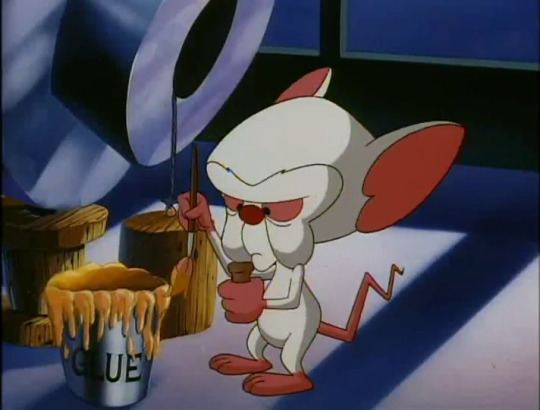
So as we can see, Brain is, as usual, back to work on another plan that involves—
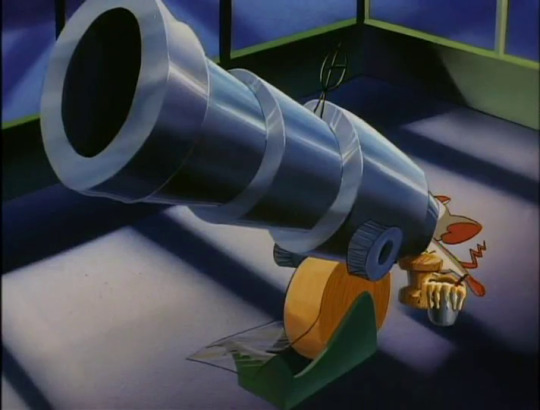
—a goddamn cannon, holy shit! What is he using the glue for? That’s a little ominous, given what’s been involved in this episode.
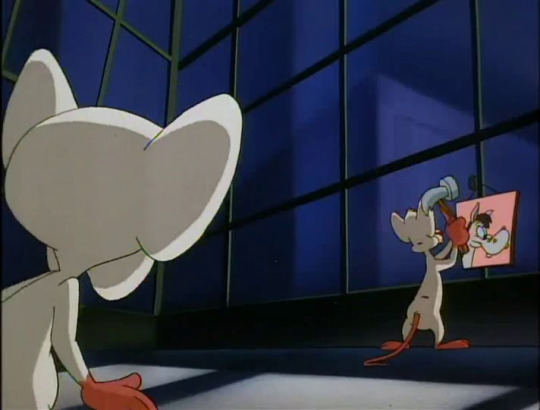
There’s a hammering noise in the background and we see Pinky putting up a photo of Phar Fignewton.
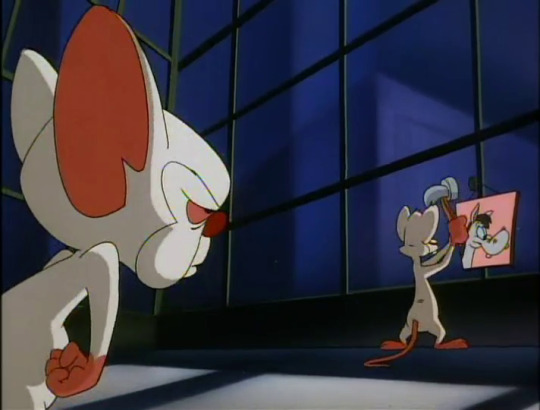
“Pinky, will you please stop that? I’m trying to concentrate on tomorrow night!”
Wow, you’re more irritable than usual, Brain. I didn’t think some delicate hammering would annoy you that much.
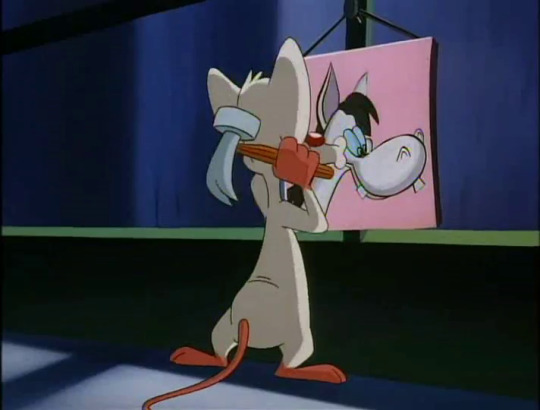
“Mwah!~”
…Despite my ramblings earlier, that’s very cute of you, Pinky. I’m sure you could’ve gotten a better photo, though.
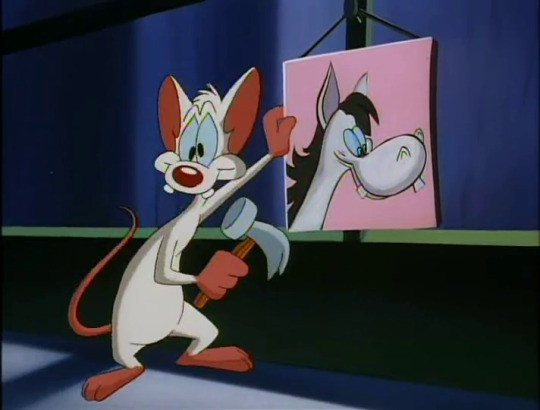
“Why, Brain, what’re we gonna do tomorrow night?”
Try to take over the world, of course! Right, Brain?
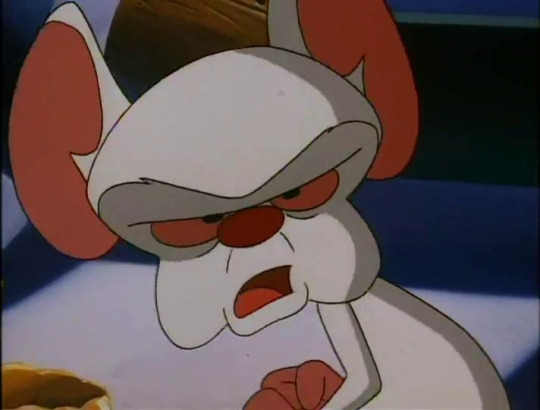

“Guess.”
…
Umm, wow. That’s a first. You look like you’re absolutely enraged, Brain. All this over some hammering sounds?
This had me taken aback a bit when I watched it the first time, not gonna lie. We’ve seen Brain after a plan’s failure plenty of times before. He’s been frustrated, sure. Humiliated at times, or maybe he just sighs in resignation and walks off into the sunset. It always ends with him simply using these feelings to fuel the fire in him to do better tomorrow night.
This is the very first time we’ve seen him jumpy and irritated at the most minor of things and so angry that he literally refuses to participate normally in his and Pinky’s shared catchphrase. And this was for a plan that was just to fund the real plan! So why is this time any different?
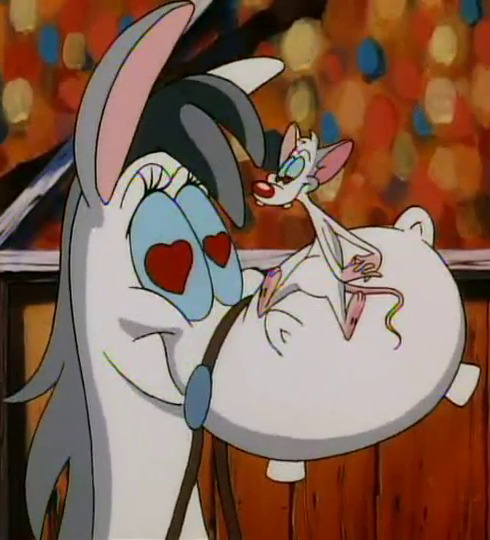
Oh.
OH.
Okay, that’s… That makes a lot of sense, actually. Damn.
Hey, fanfic writers? Ya’ll ever use this as the very first time Brain experiences romantic jealousy? Let me know.
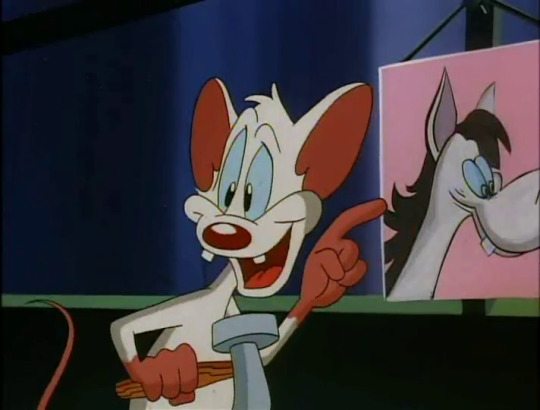
“Oh yeah, try to take over the world. Right.”
I think even Pinky’s put off by this development, if his hesitant and quiet finishing of the saying is anything to go by.
And that’s what we end off with.
All in all, this episode is a wild ride of strangeness in small moments and bizarre additions to lore and ends on the first subversion of the long-running closing gag of the series. It’s not exactly a great episode, but that ending is intriguing enough for one of the main purposes of this rewatch. In short, I’m just baffled.
Luckily the next episode is much better. Next time, the mice head on down to Tennessee to seek world domination via country music.
See you then!
21 notes
·
View notes
Text
it is still ZOIDS HEADCANON TIME
PART 2 because i’m ridiculous
I'm operating on the assumption that by the time humans colonized Zi they'd spread out pretty well across the rest of the galaxy and p...ossibly made contact with extraterrestrials, mainly because I like to imagine there's intelligent life out there somewhere. (Intelligent life hat does not look Exactly Like Humans with extra bits stuck on.)
When the Human Federation or w/e discovered Zi and decided it would be feasible to colonize it, there were a lot of engineers/science-y types who really wanted to tinker with robot animals that ended up volunteering and being chosen for the initial expedition, along with various other types you'd want along to build a civilization on a distant planet. The mechanical organisms were initially dubbed Zi-oids, which over time became corrupted into the simpler name Zoids. After being tamed, they proved useful as pack animals, modes of transport, farm hands and companions. Contact with organoids started off pretty hostile but became more relaxed as time went on, per the other post. Eventually, the colonists developed quite advanced (though still very small) Zoids with respectable combat capabilities, designed primarily to protect them from attack by wild Zoids.
At this point only a small portion of the Western Continent had been settled, and while the rest of it still needed to be explored some of the settlers were eager to see what the planet's other continents were like; exploration of these was hindered by savage magnetic storms that made aerial or ocean travel a potentially deadly prospect. These people observed how organoids could seemingly defy the laws of physics by converting themselves into a pure energy state to teleport from place to place, etc. and started thinking "what if we did that, BUT WITH HUGE TRANSPORT ZOIDS" and began experimenting with smooshing together Organoid Physics-Defying Bullshit with what bits of Spacefaring Technology they'd managed to salvage from the ships that had brought them to Zi. The result was something that was eventually known as the Zoidcore Overload System, and while it was being tested one day, something went horrifyingly wrong and - to all outside observers, of which there were admittedly very few - the entire settlement vanished without a trace.
IN REALITY it had been transported back in time thousands upon thousands of years, which is blatant Time Travel Bullshit but o well. (Also Legacy gave us canon time fuckery so god dammit, I'm gonna use it.) The colonists were disoriented, frightened and cut off from any further contact with their homeworld, but since the entire settlement with all of its farms, greenhouses and other resources had been displaced together, nobody was quite as badly off as they could have been. Shaken but determined, most of the colony pulled themselves together to push onward with their lives.
Some of the colonists were pretty mad about being temporally displaced and wanted someone to fix it, which of course was impossible, but they attempted to use force to make it happen and got booted out of the colony for being asshats. Taking their Zoids, organoids and whatever supplies they could carry with them, they wandered off and eventually started another settlement elsewhere. Both settlements continued developing Zoids, albeit now with more of an eye toward combat practicality now that they knew they had enemies out there.
As this went on, organoids started evolving too - originally small, drab creatures who oversaw whole swarms of wild Zoids as their charges, their species eventually started selecting for individuals who bonded with the human settlers and their Zoids; these specimens grew larger, displayed higher intelligence due to the mental bond they shared with other sapients, and thrived in comparison to their wilder counterparts. They also led less stressful lives as they tended to a single, relatively sedate Zoid rather than having to protect and heal numerous creatures that were constantly being preyed upon by each other. (They also happened to evolve in a variety of bright colors, due to their human companions’ natural preference for such things.) Eventually, wild organoids were all but extinct on Zi.
Before too long the colonists discovered the thing they wound up calling Zoid Eve and built the city of Eveopolis around it. As their population grew and prospered, they made great technological advances and started improving themselves using computerized implants that allowed them to bond more closely with their Zoids, utilize remote "drone" units, and grant some of them seemingly supernatural powers. They ceased to think of themselves as humans any longer and began calling themselves Zoidians.
Then everyone started fighting over Zoid Eve, the Death Saurer happened, the Zoidian race was decimated after thousands of years of prosperity, and the last handful of survivors went into stasis.
MEANWHILE, ON EARTH
The governments of the world are wary of Zi. Something bad happened there; they’ve never gotten to the bottom of what caused that first colony to disappear decades ago. It also seemed to have undergone intense environmental changes - huge swathes of the planet’s western continent are barren desert. It’s basically everyone’s last choice of planet to try and settle.
The fifth son of a royal family has become deeply dissatisfied with his station in life. Young and ambitious, he’s hungry enough for power that his elders can see he poses a problem, and devise a means of getting rid of him: they charge him with taking a group of imperial citizens to Zi to establish a branch of the royal family there. The prince knows what they’re trying to do but can’t reasonably defy the order, so he goes.
Thus, Zi is claimed (reluctantly) for the Guylos Empire.
The settlers find the planet tolerable, if not exactly welcoming. They’re hardy folk from having survived on an increasingly inhospitable Earth, and are willing to work hard to make this new world their home. They have great success adapting the planet’s native life forms to their uses, and soon have a stable, vibrant civilization living and working alongside Zoids. Their emperor, too, is pleased with the success of this venture; it wasn’t the kingdom he’d dreamed of, but it is his, and his people are prospering under his rule.
The settlers are curious, of course, about the remnants of a past civilization that they eventually find - ruined structures here and there, the ossified remains of what are definitely Zoids but quite unlike either the wild specimens or anything human engineers have yet come up with. But much of their lives are taken up by simply living; they focus on the present in order to build themselves a stable future, and have no time to dwell on what happened in the past.
Within a handful of generations, some of the Guylos citizens grow restless and crave freedom from their Imperial masters. They break off and form the Helic Republic. The Empire does not suffer this gladly, and war breaks out, raging for several years before an uneasy truce is reached to allow the battered forces of both sides to recover.
The arms race triggered by the outbreak of war drives both the Empire and the Republic to excavate countless ruins of the civilization that called themselves Zoidians. They make amazing discoveries - advanced technology whose workings they can barely comprehend; Zoids of incredible complexity, though their operating systems and user interfaces render them all but unusable to humans; and capsules. Rows and rows of capsules, in some places - always a large one accompanied by a much smaller one. Very few of the small capsules prove useful - the rooms in which they are found are often partially destroyed, the capsules breached by falling debris or the ravages of time - but the larger ones often bear fruit in the form of small, startlingly intelligent Zoids with incredible abilities.
By incorporating elements of ancient Zoidian technology into their designs, the humans of Zi quickly develop more effective weapons - more efficient ways of killing each other. By the time the truce is reached, Zi’s inhabitants are bone-weary of conflict, many living in worse conditions than their ancestors of centuries past. While several large cities remain standing - most notably the capitals of the Republic and Empire - most of Zi’s inhabitants are reduced to small settlements, relying on subsistence farming or trade to support themselves, and constantly under threat of attack by bandits or other troublemakers. It’s a difficult life, but the Zians determinedly struggle on. Giving up is not in their nature.
THEN CC/GF HAPPENS
Afterward, a small handful of people (mostly military) are aware of the existence of Ancient Zoidians, Organoids and Zoid Eve. The Death Saurer and Death Stinger are eventually relegated to "wew lad good thing we weren't around for that shit"-style legend. Helic and Guylos remain on mostly good terms in the ensuing decades, both bonded and scared shitless by the whole Death Zoid mess. People start using Zoids in happy pretendy funtime battles, and the world at large is a pretty swell place to live.
And then the Backdraft starts digging up Ultimate X Zoids and some other fuckfaces stick Ancient Zoidian AIs into Raynoses that end up being sold to the general public.
Something something Gilvader.
17 notes
·
View notes
Note
Hi, I ADORE your smut! I just binged through all of it this long weekend! I really think it stands out in the way you stress importance on consent in particular! Usually I'm actually more into dub-con (I don't know why, but I just find it really sexy? probably not good??) but YOU manage to write consent extremely sexily? I'm sorry if this sounds totally weird, but I wanted to say that. And I also wanted to ask you why consent plays such a big role in your writing? I find it really striking!
Hello my dear anon!!! Thank you so much for this ask AND for reading my smut, and I am SO happy that you enjoy it!
Now, warning ahead. You asked why consent is important to me, and even told me I managed to show you some sexy in it, even though you usually don’t go for it, which is SO FRIGGING GREAT TO ME, but so my answer will be both personal, and science-y, and LENGTHY, so… at your own risk, lol? You asked a psychologist sex researcher this question. And so this is the answer you are getting.
So, to answer your question, let me start a little broader:
Sexual desires are pretty damn diverse. And what you desire can be immensely specific. And that’s a good thing – just like you wouldn’t want everyone to be into wearing the same sparkly hoodie and nothing else but that, you wouldn’t want them to only desire gals with red nail polish. So, here, as with anything else, diversity is something that makes us richer.
Among the diversity in sexual desires are factors we can distinguish, though. Where we can group them specifically. Gender and bodytype are among those. Many people desire one specific gender in the gender spectrum, some don’t, you know this one. But sexual desires and orientations really don’t stop at one gender. Just because you’re into guys doesn’t mean you’re into every man that ever walked this earth. Your desires are more specific than that. So, there are other factors than just gender. One example that I already named is bodytype. And it is also a factor on which I can illustrate the following very well: Variance and diversity is good. But bodytype preference specifically shows us that we are not as diverse as we should be in this regard. If this were a normal distribution, we should have way more variance in what bodytypes people desire. And in fact, statistically seen, we do see that desired bodytypes vary slightly more between both hetero- and homosexual women than they do in men; but in no gender they still vary as much as they “should”. One possible and plausable explanation for this (tho not exclusive! Looking at you, evolutional psychology) is: We are influenced in our preference. By media, by zeitgeist, by the judgemental comments of those around you, by mere exposure even (i.e.: what you’re used to seeing more often!). Heterosexual cis-men might so overwhelmlingly prefer smaller, slender, tight, overtly youthful bodytypes in part because so many accumulating influences have taught them to. And, because once preference is formed (during and around puberty) it’s highly fucking stable and can not be nudged (see those harmful streams of psychology and pseudo-psychology that have tried to “convert” homosexuality in the much-too-recent past!), these influences are a very powerful and lasting influencial thing! Because we don’t CHOOSE what we desire. It forms without our will, and stays like that (though obviously you can discover sides to it later on that you never even knew were there! Especially because in most cases, we are not exclusive in our desires, and there are more sides to it we have yet to discover!)
So. Anyway.All this I said to make the following point:
Another factor (just like bodytype or gender) in which we statistically distinguish sexual desires in the scientific literature about it, is if people sexually desire consenting sex vs. non-consenting sex. As we saw with bodytypes, what we see and what we’re used to seeing has an effect on what we end up desiring once puberty has finished forming our from-then-on stable desires. Now, please remember we tend to live in what we commonly name a “rape culture” almost everywhere around the world, some places more overwhelmingly “heavy” on it than others. And we do tend to see the correlation that in countries where pornographic material contains exponentially more depictions of rape and non-consenting sex and coercion, where the overcoming of a “no” and the exploitation of helpless sexual partners gets romanticized a lot (looking at you, Japanese porn), more people desire non-consensual sex over consentual sex than in countries where more explicitly non-consentual content is banned. And while way more motivation is needed to commit a sex crime than just sexual arousal towards an individually desired stimulus, it is certainly a risk factor (one that goes both ways, mind you: if you’re into the idea of non-consexual sex, for whatever reason, you’re both more likely to become a perpetrator OR a victim!)
So, what I’m saying here very lenghtily (sorry!): With my fics I write sexual media. From my own experience I can very much attest to the fact that pubescent kids read smutty fanfiction. I did back then. It was my first introduction into sexual media as a kid. And lots of sexual media, especially mainstream pornography but not exclusively, contains non-consenting sex which seems to be one factor among many that has the power to influence kids in their puberty to develop sexual desires for those depicted stimuli.
This is of course not to say that it’s bad to be into a little “dub-con”, as you say. I myself enjoy consentual powerplay A LOT. You know, depictions of sex where one of the partners gets restrained by the wrists, or frantic sex that can turn a little rough (even when, for me, it’s important that this is ok by both partners very much explicitly!), or quickies without much foreplay and a lot of frenzy that are incredibly arousing to me if the emotions are all laid out for me to read! But I also know I had no choice in desiring this, this is the result of the cocktail of influences both internal and external that I was exposed to until my sexuality fully formed. And I can’t tell you if depictions of dominance and powerplays however consensual might not absolutely turn me off if I’d not grown up in an environment that romanticizes this as I grew up! I might have learned this, in part, through sexual media that I consumed during the onset of my puberty.
And this is one of the many reasons why depictions of consent in the sexual media that I put out is so important to me. I play a teeny tiny part in this grand picture. My fics might be what two, three, ten kids during their puberty consume. And I feel a responsibility towards these two, three, maybe 10 kids that read my content, to put out something where I have the power to not contribute to this rape culture, and instead depict a sexuality that can be communicative, consensual, mostly realistic and still arousing. At least I strive towards that goal, and find some meaning in it!
ESPECIALLY because of my field of work in sexual aggression research, AND because in mainstream media, outside of porn, sex either gets censored completely, or it gets only depicted if it’s problematic! We tend to see a lot of rape in media. In books, in shows, in films. It always tells a narrative. But we rarely get shown explicit, healthy, empowered sexual content where both partners are into exploring every last kink they share!
So yes, there are many people who find a little dub-con, or even non-con, very stimulating. And there is nothing at all wrong with that! (You know, as long as you don’t harm anyone, this goes without saying!) Nobody chooses what floats their boat and it should be completely judgement-free as long as no one is harmed by it. And some people suffer a lot by what they like, too, even if they had no hand in deciting what got them going, which is a whole different topic in and on itself.
It doesn’t mean people aren’t valid in their desires whatever way they are formed sexually.
But I choose to contribute in this teensy-tiny way that I can, that someone who gets exposed to sexual media by me first, might find some kink in consent and communicating their needs to each other. I believe the world would be a safer place if more people were to get turned on by consent. So that is one reason why I always address it, and try to work it into even the most problematic of tropes, because I believe it can be done and I believe it can be done in very arousing ways!
(And yeah, sorry for the length… I was very happy about getting this ask?)
#my mustard#on lemons#on writing#sorry to turn this all ted-talky#if you want sources for the studies lemme know and i'll recommend some to you#on consent#🍋
57 notes
·
View notes
Photo

The Oceans of Earth
by Kurt Cagle
Infographic via Study of diamonds reveals that water exists in Earth’s mantle
Around 4.5 billions of years ago, a large blue giant star in the Milky Way’s Orion Spur went supernova, spreading a massive shockwave and peppering nebulae with heavy elements like iron, nickel, uranium and lead. In the wake of the shockwave, one particular nebula collapsed, creating several protostellar nebulae that began to glow hot as stars formed within.
One of these stars, Sol, formed as a yellow-white main stream star, considerably weaker in strength than it would eventually become, and the fusion of this event created smaller shockwaves that caused the formation of rings, like a rock dropped into a pond creates rings. Irregularities in those rings eventually collapsed into dozens of planets, ranging in size from massive gas giants like Jupiter to Gaia, which was a planet about 80% the size of Earth. The orbits of these planets were highly chaotic, and a significant number of them were expelled from the solar system by the trio of Sol, Jupiter and Saturn.
During this period, maybe 200 million years after Sol had achieved fusion, young Gaia was in its Hadean phase. The planet had formed a nickel iron core, but in the process had also absorbed huge amounts of lighter elements such as silicon, nitrogen and water molecules (which were extremely stable, even under high pressure). The water involved was not free-floating, but instead was locked under great pressure into obscure “super-ices”, which “melted” at several thousand degrees Kelvin. Convection had begun within the mantle, causing hot magma formed by both the initial formation and the presence of a significant percentage of radioactive uranium, thorium and other heavy metals to bubble through to the surface.

As it did, the locked water went through several different phase transitions, eventually coming to the surface as steam, which (along with ammonia, methane and oxygen that had been dissociated from water) formed a thin atmosphere. The original atmosphere would have been quite toxic and very likely superheated, and would have looked a lot like the atmosphere of Venus except with less sulphur and much more water vapor, which would have served to trap in much of the heat from the surface rather than letting it escape into space.
The lava fields were heated from below, but in time there was enough of a difference in temperatures that the lava would begin to crust over. As it did, the water vapor’s own convection cycle would introduce a phase where the vapor would reach a sufficient density to convert to liquid rain, where it would then hit the surface and immediately burst into steam again, though each time, transferring more and more heat from the surface. A more or less uniform crust began to form, one that was quite thick in places, floating atop a sea of magma.
The water vapor cycle eventually became driven less by outgassing and more just by surface to atmosphere convection, and the seas formed. The planet would have been a blue marble, with an atmosphere in which most of the water had precipitated out, leaving primarily molecular nitrogen, methane, a small amount of oxygen, and limited amounts of carbon dioxide and sulfur dioxide. There would have been very little land — most of it was more than twenty kilometers under the surface of the sea, with only the tops of volcanoes occasionally breaking the surface.
Things would have remained like this for a while, were it not for what was happening out in space. The big gas planets were in orbits considerably closer to Sol than they are today (they are spiraling outward), and in the process were “playing pool” with the smaller rocky planets through the magic of n-body orbital dynamics. One such planet, which astronomers now refer to as Thea, was about the size of Mars. It was knocked into an oblique orbit around the sun that was a resonance orbit (one that naturally formed because of gravitational effects) with Gaia’s. The inevitable occurred.
youtube
Had there been observers on Gaia, they would have observed one planet that would have looked like a small moon (if the moon had been around then) though its size would have waxed and waned dramatically (sometimes it looked like a large moon, sometime it was not even visible in the sky. Then, one year, Gaia would have looked larger and larger in the sky, until it occupied several tens of degrees of arc. Of course, if you did see it, chances were almost certain you wouldn’t later on.
The resulting impact vaporized the crust of more than half the planet, as well as punching a hole in the opposite side due to sound wave dynamics. The oceans flashed to steam (much of which was lost to space), and the mantle boiled out even more water vapor. The crust that remained cracked, forming the primordial tectonic plates, as Gaia grew in size by nearly 20%. Thea’s core sank deep into the mantle and then the core, creating a bi-lobed core that wobbled because of its asymmetry, that wobble being the cause of the Earth’s precession through the species. The ejecta from the impact also formed a ring around the Earth much like Saturn’s ring, and the planet returned to a Hadean existence for another billion years or so.
Yet the same cycle eventually asserted itself, faster than before because the newly formed Earth (from Gaia and Thea) was larger, because the initial heat that had formed the planet had peaked and waned, and because a new dynamic had taken hold. The original crust was now broken up into very thick sheets, while the newer crust that formed in the wake of the Thea’s collision were thinner, even as the moon coalesced out of Earth’s rings.
youtube
This caused the single large proto-continent to start splitting off, establishing anchor points for methane bringing micro-organisms to make their way more effectively to the surface in tidal pools of ooze. Here, these methane eaters (methanogens) produced waste products of oxygen. About two thousand million years ago, enough oxygen had entered the atmosphere that methanogenic life was asphyxiating. Past a certain point, without the presence of a trace amount of carbon dioxide in the air, heat radiates from the planet rather than being captured by the atmosphere, and there is some evidence that the planet had dropped to the point where most of the seas (save perhaps for a thin band around the equator) was ice or slush.
More than likely, there was another reasonably large impact around 2.5 billion years ago that released enough water vapor and methane into the atmosphere to re-establish life, but, in the interim, oxygen breathers (the first Eukaryotes or “good bacteria”) had also begun to evolve at or near the surface. The ice retreated for a while, though by 800 million years a slushball earth condition held until about 550 million years ago, giving rise to complex multicellular organisms that breathed oxygen and produced carbon dioxide as waste. Methanogens still exist, but they do so primarily around deep sea vents and frozen methanogenic clathrates along the continental shelves.
The Cambrian explosion shifted the balance, giving all of the right conditions for complex life to take off. Life existed on the Earth almost from its inception, but the conditions on the Earth had to reach the right equilibrium for life to thrive. The future of Earth’s Oceans may be as complex as their past. For the next several hundreds of million years, the oceans will likely remain in equilibrium, but the Sun becomes a problem. Sol, like most stars, is in a state of equilibrium because hydrogen fusing into helium pushes back on the weight of that hydrogen. There was also a legacy amount of helium in the star, which requires higher temperatures and pressures to fuse, but which produces far more energy in the process. The helium is pushed to the core, but forms its own convection loop as the pressures become enough to ignite it. This makes the overall star brighter and hotter over time, as more energy emerges from the core.
The seas are not currently replenished in any significant way. The Earth’s dynamo, the two spinning cores from two planets, will actually continue to slow down over time and the wobble of the planet’s precession will likely become more erratic. This will also weakens the Earth’s magnetic field and Van Allen belts, meaning that more radiation makes its way to the surface. In time, between one billion (one thousand million) and 1.5 billion years, the Oceans of Earth will dry up. Life as we know it will likely not be feasible after then (and quite possibly will become too brackish within five hundred million years).
youtube
However, this isn’t quite the end of the story. Around 5.5 billion years from now, the pressure from the growing helium shell in Sol exceeds that of hydrogen, and the sun begins to expand dramatically. This phase is comparatively brief, lasting for only a hundred million years or so, but it will be more than enough to engulf and destroy Mercury and Venus (and possibly Earth). Ironically enough, if the Earth survives there will likely be a brief window where the heat from the sun is sufficient to cause the remaining ices within the Earth’s core to turn into steam, so the the Earth will resemble Hadean Gaia again, albeit with an atmosphere mostly of water vapor, as the Sun recedes there will be a short period of time, a few hundred million years at the most, where the Earth will have Oceans again.
Sol will likely go through one further nova like expansion when it begins burning through it’s carbon core, but the impact on Earth will be considerably less extreme. The resulting stellar corpse will be a white dwarf, about half the mass and ten times its present size, with a considerably lower luminosity.
The presence of mantle water in diamonds, however, raises the possibility that other solar systems could have the requisite conditions for oceans. Already ice moons and dwarfs have been discovered in the solar system — Jupiter’s Europa, Saturn’s Encaledus and Titan, and Ceres in the Asteroid Belt all show indications of having some kind of ice core. Ironically, stable red dwarf stars, such as Proxima Centauri (which has shown evidence of planets) could very well have the necessary prerequisites for trans-billion year life.
youtube
One other factor may come into play. In about four billion years, the Andromeda and Milky Way galaxies will sideswipe, before recoalescing and hitting one another squarely about two billion years later. The likelihood of physical collision is, even with billions of stars, almost non-existent, but the chances that solar and even planetary orbits will become disrupted is considerably higher. Similarly, rogue stars are periodically ejected from the galactic core, and the chance is still small enough even over this time that it would come close enough to disrupt a solar system, the chance is still greater than zero.
Thus, it is possible that, at some point in the far distant future, the Earth is flung into space, under a planetary cap of ice, taking heat for a civilization from the still sizable radiation energy coming from the Earth’s core. Time is deep and vasty as the seas themselves.
Kurt Cagle is an author, futurist, and information architect. He writes regularly on Medium.com and Linked In, when not working on novels or writing code. | original link
1 note
·
View note
Text
Lime production technology
Product introduction:https://www.cementepc.net/epc/Cement-Production-Line.html
Lime is a necessary auxiliary material in the process of steelmaking, and its quality will directly affect the amount and quality of steel.
Although our country is energy superpower, but due to backward technology, especially the old kiln burning limekiln type and soil pollution, poor quality, high energy consumption, low yield, short of steelmaking requirement about the quality of the white, compared with the mechanical automatic calcined in the world, the gap is quite big, at present our country 70% lime kiln kiln is no environmental protection measures, protected by local survival, but all regions, all kinds of industrial pollution has caused the state attaches great importance to, thus eliminating soil lime kiln burning,To build our own modern white ash kiln with energy saving, environmental protection and high efficiency is not only the requirement of national environmental protection, but also the imperative measure of hundreds of thousands of lime production enterprises in China.The following is a simple analysis of lime raw material, calcining fuel, calcining equipment and process.
1 raw limestone
Limestone is a kind of rock formed from sedimentary source, which is alkaline rock and is mainly composed of calcium carbonate, calcium magnesium carbonate or a mixture of calcium carbonate and magnesium carbonate.Limestone has good processing, polishing and good cementing performance, insoluble in water, soluble in saturated sulfuric acid, can react with strong acid and form corresponding calcium salt, and release CO2 at the same time.
1.1 impurities in limestone
Because limestone (CaCO3) is a natural mineral, it contains impurities that are not conducive to calcination.The impurities are mainly SiO2, AL2O3, Fe2O3, K2O, P, S, etc.
1.2 size of limestone
In the process of limestone calcination, the influence of the particle size of raw limestone is very large. Because CO2 separation is carried out slowly from the surface of limestone to the interior, the calcination with large particle size is more difficult and takes longer time than that with small particle size.Through scientific test and analysis, the calcining time at a certain temperature is proportional to the square of the thickness of limestone, and the calcining time of 80mm stone is 4 times that of 40mm stone.Practice shows that the best effect is to choose limestone with particle size of 40-80mm for shaft furnace and 10-30mm for rotary kiln.
1.3 selection of limestone
Limestone with high density of calcium is not easy to burn, but the lime and gray matter after calcination is good. On the contrary, limestone with low density of calcium is easy to burn, but the gray matter after calcination is poor.The content of calcium and other substances in limestone is determined by chemical analysis, wear test and calcining test.Generally, the CaO content of high-quality limestone is more than 52%, MgO content is less than 3%, and SiO2 content is less than 1%.
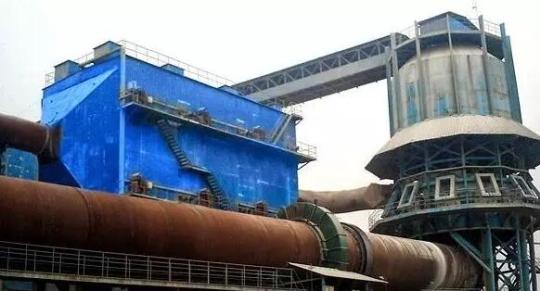
2 fuel
There are many fuels for calcining limestone.There are solids, liquids, gases and so on.
Solid fuels are mainly coal and its processed products.Coal is an important energy source and chemical raw material.The best coal for calcination of limestone is the one with high calorific value and low S content.But using coal as fuel is costly and polluting.
Liquid fuels are petroleum and processed products.Most of them are atomized and diffused by atomizing devices.But also because the production cost is too high pollution is generally not used.
There are many kinds of gas fuels, such as coking gas, producer gas, natural gas, blast furnace gas, converter gas and so on.Gas fuel is beneficial to improve thermal efficiency and save energy.Compared with coal burning, gas fuel can increase thermal efficiency by 2 times, and oil by 1 times.And gas fuel is conducive to protect the atmospheric environment to reduce NO Χ and SO2 emissions.Therefore, it is recommended to use gas as fuel for calcining limestone.
(1)Gas burning lime kiln to save energy
Especially the use of residual blast furnace gas and coke oven gas, and other industrial furnace residual gas is the largest energy conservation and utilization.
(2)Favorable environmental protection
Because the gas kiln does not have a large number of harmful gases discharged after solid fuel combustion, and the original gas discharged to the atmosphere also reduces the emission of pollution to the atmosphere after fuel, so it is very beneficial to environmental protection.
(3)The temperature in the furnace is uniform
The calcined lime is of good quality.The gas fuel can be burned in all the voids in the limestone without any dead space, and the temperature may be high or low if the coal is used as fuel.Because the flame of gas burning is uniform and at the same time exothermic, it can achieve fast combustion and fast cooling, so the lime activity is good.
(4)In addition, it is convenient for detection and good operation
Because the temperature, gas, air flow and pressure of the gas kiln can be measured by the instrument, the furnace operator can master the furnace state and adjust the furnace state according to the test data, unlike the solid fuel is difficult to control, even if the furnace stopped the gas is still burning, the gas kiln adjustment cycle is short, the solid fuel kiln adjustment cycle is long.
The most ideal gas fuel is blast furnace and coke oven gas, but coke oven gas calorific value is too high, and must take off tar, so it is not easy to control the use.
3. White ash calcining equipment -- white ash kiln
There are many kinds of old furnace type white ash kilns.Such as earth kiln, common shaft furnace, rotary kiln and so on.Among them, the earth kiln and the common shaft furnace type ash kiln, which USES coal as calcining fuel, are elimination equipment.Nowadays, shaft kiln and rotary kiln which use gas as fuel are mostly used.According to the furnace volume, the normal vertical kiln can be divided into 25, 50, 140, 180 and 300M3.Smaller is easier to master.Now take 140M3 white ash kiln of common gas fired shaft furnace for analysis:
The outer diameter of annular concrete foundation wall is 3.95m, the wall thickness is 400mm, the upper elevation is 4.9m, the outer diameter of steel kiln shell is 4.29m, the highest elevation of the upper roof is 26.55m, that is, the metal kiln shell is 22.05m high, the inclined bridge top is 31.25m(elevation), the kiln inner diameter is 3m, the material column is 20m high, and the effective volume is 140m3.There are 6 test thermocouples, one at the position of 5.6m, two at the position of 10.8m, two at the position of 14.8m, and one at the position of 23.5m.There are 16 burners at elevation 13.3m and 16 nozzle (burners) at elevation 10.8m.Combustion air casing 16 side shape, diameter 325mm, opposite to the burning nozzle center, cooling air casing 300*250;Blast hole ф 250250 tossing in the ground operation;Cooling fan, combustion fan 6.3a,30Kw. Hoist 3 tons 18-22kw.
Design requirements:
raw material particle size 40-80mm, gas calorific value 860*4190KJ/m3, flow 7000m3/ hour, design utilization coefficient >0.6.
To be continued
Ratio of gas and air in the 2-1 and 1:2. 5, calculate the cycle of the furnace, put the ashes of time, according to the cycle regulation 130 cubic grey interval generally in a lime shaft kiln, such as the gas pressure, when air pressure is 10000 mpa, 60 minutes, put on a gray one-time about 7 tons of stone, keep good stable material surface, plus or minus not more than 10 centimeters, can be a good grey.
For more information about cement production line, please consult our customer service or leave a message. We will reply to you as soon as possible.
The page source:https://www.cementepc.net/company/Lime-production-technology.html
0 notes
Text
How to make humus ? and What is humus ?

Hummus is a popular Middle Eastern appetizer. It is made by mixing chickpeas or beans, tahini (sesame seeds), olive oil, lemon juice and garlic in a food processor. Humus is not only a delicious variety of appetizers, it is a food that has all-round health and nutritional benefits with its rich nutrients. The 8 scientifically proven benefits of humus are as follows:

1. Very Nutritious and Plant Based Protein Source
Humus is nutritious because it contains a wide range of vitamins and minerals. The nutritional value of a 100 gram (3.5 ounce) humus portion is as follows:
• Calories: 166
• Fat: 9.6 grams
• Protein: 7.9 grams
• Carbohydrate: 14.3 grams
• Fiber: 6.0 grams
• Manganese: 39%
• Copper: 26%
• Folate: 21%
• Magnesium: 18%
• Phosphorus: 18%
• Iron: 14%
• Zinc: 12%
• Thiamine: 12%
• B6 Vitamin: 10%
• Potassium: 7%
Humus is an excellent source of plant-based protein that provides 7.9 grams per serving. This makes the humus a great option for those on a vegetarian or vegan diet. Consume enough protein is essential for optimal growth, healing and immune function. In addition, humus contains iron, folate, phosphorus and B vitamins, which are important for vegetarians and vegans, who cannot get enough from their diet.
2. Contains Ingredients Proven to Help Fight Inflammation

Inflammation is a way of protecting the body from infection, disease or injury. However, sometimes inflammation may remain in the body for longer than necessary. This is called chronic inflammation and has been associated with many serious health problems. Humus is full of healthy ingredients that can help fight chronic inflammation, and olive oil is one of them. It is rich in powerful antioxidants with anti-inflammatory benefits. In particular, extra virgin olive oil contains the antioxidant oleocantal, which is widely believed to have anti-inflammatory properties similar to anti-inflammatory drugs. Similarly, sesame seeds that produce tahini can help to reduce signs of inflammation in the body, such as IL-6 and CRP, which are elevated in inflammatory diseases such as arthritis. Moreover, many studies have shown that consuming a diet rich in legumes such as chickpeas,
3. Promotes Digestive Health and Nourishes Good Gout Bacteria
Humus is an excellent source of dietary fiber that can improve digestive health. It provides 6 grams of dietary fiber per 3.5 ounces (100 grams). This is equal to 24% of daily fiber advice for women and 16% for men. Humus can help keep the digestion regular thanks to its high fiber content. This is because dietary fiber helps soften the stool so that it can pass through the intestines more easily.
Dietary fiber also helps to feed healthy bacteria living in the intestines. One study found that the addition of 200 gr of chickpea (or raffinose fiber from chickpea) for three weeks helped reproduction of beneficial bacteria, such as bifido bacteria, and helped suppress the growth of harmful bacteria. Some of the fibers in the humus can be converted to short-chain fatty acid butyrate by intestinal bacteria. This fatty acid helps to feed colon cells and has many impressive benefits. Laboratory studies have shown that butyrate production is associated with lower risk of colon cancer and other health problems.
4. Controls Low Blood Sugar
Humus has several properties that can help control blood sugar levels. Humus is mostly made from chickpeas with low glycemic index (GI). Glycemic index is a measure of the ability of food to increase blood sugar. Foods with a high GI value are quickly digested and then absorbed, resulting in a sharp rise and a decrease in blood sugar levels. Conversely, foods with a low GI value are slowly digested and then absorbed, causing a slower and more balanced rise and a decrease in blood sugar levels.
Also humus is a source of healthy fat and a great soluble fiber. Chickpea is rich in protein, slow starch and antinutrient which slow down carbohydrate digestion. In addition, fats help to slow the absorption of carbohydrates from the intestine, which leads to a slower and more stable release of sugar into the bloodstream. For example, research has shown that although white bread provides the same amount of carbohydrate, it releases four times more sugar into the blood after a meal than humus.
5. Contains Components That Can Reduce Heart Disease Risk
Heart disease is responsible for 1 out of every 4 deaths worldwide. Humus contains several components that can help reduce risk factors for heart disease. In a five-week study, chickpeas or wheat were added to 47 healthy adult diets. After the study, those who eat extra chickpeas have a bad LDL cholesterol level of 4.6% lower than those who eat extra wheat. In addition, a review of 10 studies with more than 268 people concluded that a diet rich in legumes such as chickpeas reduced bad LDL cholesterol by an average of 5%.
In addition to chickpeas, humus is also a food that is obtained from olive oil and which is suitable for heart health. The analysis of 32 studies with more than 840,000 people found that those with the highest healthy fat intake, such as olive oil, had a 12% lower and 11% lower overall risk of death from heart disease. Another study found that the risk of heart disease was reduced by 10% for every 10 grams (about 2 teaspoons) of extra virgin olive oil consumed daily. Although these results are promising, further studies on humus are needed.
6. Helps to Lose Weight

Several studies have examined how humus affects weight loss and maintenance. Interestingly, according to a national study, those who regularly consume chickpeas or humus are 53% less likely to be obese. In addition, their BMI is lower and their waist size is 2.2 inches (5.5 cm) smaller on average than people who do not consume chickpeas or humus. However, it is not entirely clear whether these results are due to certain characteristics of chickpea or humus, or that only those who eat these foods generally live a healthy lifestyle.
Other studies have shown that intake of legumes, such as chickpeas, leads to lower body weight and increased satiety. Humus has several features that can help increase weight loss. Fullness hormones cholecystokinin (CCK) is an excellent source of dietary fiber that has been shown to increase peptide YY and GLP-1 levels. Moreover, dietary fiber has also been shown to reduce levels of the fasting hormone ghrelin. By reducing one's appetite, fiber can help reduce calorie intake, which promotes weight loss. In addition, humus is a plant-based protein source. Research has shown that a higher protein intake can help prevent appetite and accelerate metabolism.
7. Is gluten-free
Food allergies and intolerances affect millions of people worldwide. People suffering from this do not cause food allergies and intolerance disturbing symptoms. Fortunately, the hummus was edible by almost everyone. Naturally it does not contain gluten, nuts and milk, which is suitable for people affected by general conditions such as celiac disease, hazelnut allergies and lactose intolerance. Although humus is naturally free of these ingredients, it is safe to consume the entire list of ingredients as some brands may add preservatives or other ingredients. In addition, it should be noted that chickpeas are high in raffinose, a form of FODMAP. People who are susceptible to FODMAPs, such as those with bowel syndrome, should be careful not to consume excessive humus.
We’ve guided over 416,387 people to success…
If you want to lose weight seriously,
In this Guide Will Change Your Life…, you’ll get 10 breakfast recipes, 14 lunch recipes, and 14 dinner recipes, plus a companion 28-Day Meal Plan.
8. Can be added to the diet
Hummus is not only nutritious and delicious, it is also an easy food to add to the diet. Instead of high-calorie mayonnaise or sauces, pita bread can be poured on toast. Humus can also be consumed with crispy foods such as celery, carrots, cucumbers and sweet peppers. Many people think that humus has a flavor that replaces potato chips. Although humus is commonly found in supermarkets, making it at home is extremely easy and healthier. The entire process takes less than 10 minutes.
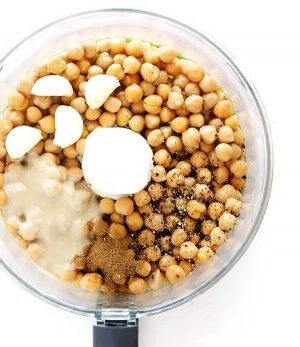
How to Make Humus?
• 2 cups of canned chickpeas (
1/3 cup of tahini)
• 1/4 cup of lemon juice
• 1 tablespoon of olive oil
• 2 cloves of garlic, crushed
• A pinch of salt
Put the ingredients in a food processor and mix until soft.
Bibliography:
conserve-energy-future.com
greenandvibrant.com
draxe.com
Read the full article
#howtomakehomemadehummus#Howtomakehumus#humerusbone#hummuscalories#hummusgoodforyou#hummushealthy#hummusnutritionfacts#hummusrecipe#humus#humusketo#Whatishumus
0 notes
Text
Novel drug could be a powerful weapon in the fight against malaria and toxoplasmosis
Princeton researchers are making key contributions toward developing a promising new treatment for the widespread and devastating diseases toxoplasmosis and malaria.
The Princeton scientists specialize in preparing the drug compound into a medicine that is both safe and effective for humans and able to reach its intended sites of action in the body in sufficient doses.
An international team of scientists found the new drug — designated JAG21 — to be highly effective against parasites in cell-based studies in the lab. After the discovery, team representatives contacted Princeton’s Robert Prud’homme for help in translating the JAG21 compound into a deliverable medication. Prud’homme is a co-author of a study, published in June 2020 in Frontiers in Cellular and Infection Microbiology, that describes the compound and its excellent preliminary results in mice.
“The results achieved so far really suggest that the discoverers of this drug are onto something,” said Prud’homme, a professor of chemical and biological engineering at Princeton. “They got in touch with us to hand over the compound so we could process it into a drug form that can be delivered. That’s what my lab does, that’s where we fit in.”
JAG21 targets a molecule that is integral for the survival of the parasites that cause both toxoplasmosis and malaria. In the study, mice that should have died from malaria instead recovered after a single, oral, low dose of JAG21. Against toxoplasmosis, the drug eradicated 100% of the active form of the parasite and knocked out more than 95% of the inactive form of the parasite, which forms cysts and has heretofore been untreatable, in mice as well as humans.
“What we’ve seen so far is pretty stunning,” said Rima McLeod, professor of pediatrics (infectious diseases) and ophthalmology/visual sciences at the University of Chicago Medicine, a lead member of the international team pursuing JAG21.
The parasites that cause malaria and toxoplasmosis are Plasmodium (a genus) and Toxoplasma gondii, respectively. Malaria is spread through bites from infected mosquitos. The resulting disease in humans —characterized by flu-like symptoms — kills half a million children every year, or one every 11 seconds, mostly in sub-Saharan Africa. The parasite that causes toxoplasmosis, meanwhile, is present in the brains of perhaps 2 billion people worldwide, or about 40% of human beings. Severe infections can cause brain and eye damage, most frequently suffered by people with compromised immune systems from cancer treatment or AIDS.
Although many treatments have been deployed against malaria, going back decades, these treatments eventually lose effectiveness as the parasites evolve resistance to them. “It’s a constant battle,” said Prud’homme.
Seeking a new weapon for the arsenal, researchers primarily at the University of Leeds and the University of Chicago screened a library of newly synthesized compounds with potential action against a critical molecule in both parasites. Although JAG21 performed admirably within samples of infected tissue, for it to work as a drug it had to be reduced in size from a large crystal. Researchers tried using a chemical solvent to convert the crystal into smaller particles. But these particles still did not metabolize well enough to enter the bloodstream, which is necessary for reaching throughout the body and effectively killing parasites.
This challenge then came Prud’homme’s way. Along with graduate student and paper co-author Kurt Ristroph, Prud’homme used traditional pharmaceutical techniques to make the JAG21 crystals smaller, water-soluble, and more easily taken up by tissues. The techniques involved thickening as well as emulsifying agents, plus dispersing of the solution with ultrasonic vibration to produce a uniform mixture. Leon Wang, a PhD student of Prud’homme’s, also assisted in the final steps of the formulation.
Critically, the resulting drug proved stable for six months when stored at room temperature. “Stability” in this case means that the molecules of JAG21 did not degrade and lose their effectiveness, nor did the molecules re-crystallize into an undeliverable form. Prud’homme compared this second aspect of stability to jarred honey kept on a shelf; over time, normally liquid honey can become too viscous.
“When you have honey, you want to keep it stored so that it stays liquid, but if it crystallizes in the jar and becomes solid, that’s a problem,” he said. “Same goes for the drug.” Demonstrating this stability is important for ensuring the drug could be stored and stockpiled in regions of sub-Saharan Africa, for instance, that do not have widely available refrigeration.
“The formulation of the drug was very simple, elegant, and really a big step toward helping this drug potentially reach the clinic,” said McLeod.
Prud’homme’s lab has long worked on translating compounds from promising drugs in theory to effective drugs in practice. Over a decade ago, the lab produced a special nanoparticle production process called Flash NanoPrecipitation (FNP), that makes drug particles even smaller by encapsulating them in a polymer-based delivery vehicle. The technology has since been used on injectable drugs for cancer and tuberculosis. More recently, the Bill and Melinda Gates Foundation began supporting efforts at Prud’homme’s lab to apply the technology to inexpensive, mass-produced medications for thwarting parasites such as malaria. That ongoing drug translation work is what ultimately connected Prud’homme to JAG21. Moving forward, the goal now is to further optimize JAG21 in the same way, making it smaller and more easily taken up by tissue.
“Our next stages are to make the drug even better with our nanoparticle formation platform,” said Prud’homme. “The drug in this way could also be made into a form that is easily deliverable as a nasal spray.”
Chicago’s McLeod is leading efforts to build a global consortium to advance the drug’s development and put it through clinical trials in humans.
“We’ve really enjoyed being a part of this overall collaboration,” said Prud’homme. “We’re happy to contribute our skills toward addressing the major challenges presented by malaria and toxoplasmosis.”
source https://scienceblog.com/518548/novel-drug-could-be-a-powerful-weapon-in-the-fight-against-malaria-and-toxoplasmosis/
0 notes
Text
Elements project- research
For a brief time, i considered looking at nuclear energy and elements involved in fission/ fusion as part of my elements project and found a highly resourceful website https://www-formal.stanford.edu with the following information on nuclear energy:
Relevant Very Elementary Physics, mostly nuclear.Up to:
FAQ on nuclear energy.
Unless one takes some rather complex facts on authority, which may be good enough depending on the authority, forming an opinion on nuclear energy requires just a little bit of physics. Let me assure the reader that nothing in what follows is controversial. Many readers will find nothing they don't already know. Here are some facts.
Energy is an additive quantitative entity. Thus if you use 50 kilowatt-hours of energy for one purpose and 40 kilowatt-hours for another purpose, then you will have to pay for 90 kilowatt-hours at the end of the month. The United States generated 2.572 trillion kilowatt-hours of electricity in 1987. A kilowatt-hour cost approximately between $.02 and $.10 in 1987 depending on the customer and the utility.
The amount of energy handled by humanity is still small compared to the amount of energy in the sunlight that strikes the earth. It's about one part in 50,000.
Energy is conserved. It can be transformed among various forms, (e.g. mechanical, electrical, chemical, heat) but the total remains the same. In each transformation, some of the energy becomes unusable, usually in the form of heat.
All matter is composed of elements. The important elements for our discussion of nuclear energy are uranium, plutonium, carbon and hydrogen. Uranium and plutonium are involved in nuclear energy production, and carbon and hydrogen are the main elements in conventional fuels like coal, oil and natural gas.
An atom of an element consists of a nucleus surrounded by electrons. What element it is is determined by the number of protons in the nucleus, but the elements come in various isotopes, and the isotope is defined by the number of neutrons in the nucleus.
Matter takes part in two kinds of reactions involving atoms of different kinds - chemical reactions and nuclear reactions. Chemical reactions are common and re-arrange how the atoms are combined into molecules but never change what element an atom is - or even what isotope it is. The reactions involved in the production and use of non-nuclear fuels are all chemical reactions.
Uranium has 92 protons. Two isotopes are important. U-235 has an atomic mass of 235 and U-238 has an atomic mass of 238. Natural uranium as it comes from mines contains 140 times as much U-238 as U-235. Because the 235 is the total of protons and neutrons U-235 has 235 - 92 = 143 neutrons.
Plutonium has 94 protons. Its important isotopes are Pu-239, which is used in power plants and bombs, and Pu-240 which is ok in power plants but which is a nuisance for those making bombs out of plutonium. There is also Pu-238 which is not fissionable but emits alpha particles and thereby generates heat. The amount of heat produced is convenient for powering spacecraft systems. There is very little natural plutonium.
When an atom of U-238 absorbs a neutron in a nuclear reactor, it becomes U-239, which decays in a short time to Pu-239. If a Pu-239 atom stays in the reactor long enough, it absorbs another neutron and becomes an atom of Pu-240 if it doesn't fission.
When an atom of U-235 or plutonium absorbs a neutron it almost always fissions. Namely, it splits into two atoms of lighter elements and emits neutrons - on the average a bit more than two. The emitted neutrons can cause further fissions in a chain reaction. In a bomb the chain reaction is very fast; in a power reactor it is slow. The two fragments are emitted at high velocity, and when they are absorbed in the fuel rod a lot of heat is produced. This heat is what powers the nuclear power plant.
Separating the isotopes of elements is very expensive. There are big plants for separating U-235 from the U-238 in natural uranium. For nuclear reactors, it is economical to use uranium that has been enriched to contain 4 to 5 percent U-235 instead of the 0.7 percent U-235 of natural uranium. Bombs need over 90 percent U-235.
Separating Pu from U is not very expensive, and bombs are mostly made of Pu made from U in special reactors in which the Pu-239 is promptly removed. In ordinary power reactors, the Pu-239 gets contaminated with Pu-240. Separating Pu-240 from Pu-239 is very expensive.
Power is measured in watts or kilowatts (1,000 watts) or megawatts (one million watts. An electric generator is rated in watts. A large nuclear power plant has a power of 1,000 megawatts (or one gigawatt). If a one kilowatt generator runs for an hour, it produces a kilowatt-hour of electric energy.
Nuclear reactions can change what element an atom is, occur on earth only under special conditions and involve something like ten million times the energy. Thus enormously more energy can be obtained from suitable nuclear reactions than from chemical reactions.
Here are some facts about nuclear power plants.
Present nuclear power plants consume uranium (specifically U-235) as fuel. When the power plant is loaded with fuel, it can run for 18 months or 2 years before it has to be refuelled, a process that takes a month or two. As the power plant operators have become more experienced, they have learned to operate longer between refuellings and take a shorter time for refuelling.
When an atom of U-235 absorbs a neutron it fissions, i.e. it breaks up in parts. These parts consist mainly of two atoms of smaller elements and some neutrons.
When a reactor is operating, fission of an atom of U-235 generates on the average a bit more than two neutrons.
If each of two neutrons produced by a fission was absorbed by an atom of U-235 the number of fissions would double in a fraction of second and then double again and again. If this were allowed to continue, in a few seconds the reactor would be generating enough power to melt.
When the reactor is turned on, the multiplication of fissions is allowed to continue until the reactor is generating power at the desired rate. Then control rods that absorb neutrons are inserted until exactly one neutron from each fission causes another fission.
Because some of the neutrons caused by a fission are emitted from the fission products only after a delay of a minute or so, it is not difficult to control the power level of the reactor. Nevertheless, there are safety systems that will shut down the reactor if the power level gets too high or if the cooling water stops flowing.
The power to produce electricity comes from the fact that the two atoms produced by the fission of a U-235 atom fly off at high speed, but they don't get even an inch before they hit something and are stopped. Stopping converts their energy of motion into heat, and the reactor heats up. If the heat weren't taken away, the reactor would melt.
The heat from fission is taken up by water or steam pumped through the reactor. The hot steam goes through turbines connected to electric generators.
About 2/3 of the heat energy is lost, and is emitted to the atmosphere or to a body of water, a river or the ocean. This loss is a consequence of the Second Law of Thermodynamics and applies to all power plants, nuclear or coal-burning.
If the highest temperature in the steam plant is T1 and the temperature at which heat is exhausted to the environment is T2, the fraction of the heat generated that can be turned into electricity is (T1 - T2)/T1. The fraction of the heat energy transformed into electric energy is called the efficiency of the power plant. For high efficiency T1 should be as high as possible and T2 as low as possible. How high T1 can be is determined by how high a temperature the materials of the reactor can be without softening. How low T2 can be is limited by the environment. Cold seawater gives a good T2.
After 18 months or two years, most of the U-235 in the fuel is used up, and the fuel rods consist mainly of the products of fission, which remain radioactive and continue to generate heat. The fuel rods are placed in large pools of water which takes the remaining heat. The fuel rods become less and less radioactive with time.
After the rods have cooled off for a while, they should be chemically reprocessed to extract left over uranium and some plutonium that has been produced. The left-over uranium and the plutonium can then be converted to more reactor fuel. The fission products can then be buried in stable rock formations.
France, Britain, Japan and most other countries have their used fuel rods reprocessed. For bad political reasons, the US stopped reprocessing and hasn't yet managed to agree on how to store the fission products. There is no actual hurry, because the fuel rods become less and less radioactive as time passes. 2002 Note: Congress has just passed a bill and the President has signed it that provides for storing the waste in tunnels dug into Yucca Mountain in Nevada. Probably this will happen, but first there will be lots of lawsuits from opponents of nuclear power.
Most environmental organizations mistakenly oppose nuclear energy. The consequence has been pollution from coal burning plants.
OK, the last two points are controversial.
I don't know if this elementary exposition is useful to anyone. Up to:
Sustainability FAQ
Send comments to [email protected]. I sometimes make changes suggested in them. - John McCarthy
The number of hits on this page since 1995 November 13.
0 notes
Text
Pixel Slate vs. Pixelbook: The productivity conundrum
New Post has been published on https://www.articletec.com/pixel-slate-vs-pixelbook-the-productivity-conundrum/
Pixel Slate vs. Pixelbook: The productivity conundrum
So maybe you’ve heard: Google’s got a new high-end Pixel product that’s finally ready for us productivity-hunting primates to purchase.
The product is curiously tough to define. It’s a tablet, but probably not like any other tablet you’ve used before. It’s a laptop, but only kinda — and with a fair number of asterisks attached. And it doesn’t run Android, exactly, though it does run Android apps and have an interface that’ll feel awfully familiar if you’ve used a recent Android phone.
The product, as you no doubt know (you smart cookie, you), is the Pixel Slate — a convertible Chrome OS computing device that doubles as both a laptop and a tablet, provided you pick up its optional keyboard accessory. On paper, it almost seems like a more versatile version of Google’s high-end Pixelbook, which is basically the same thing except with a display that swivels back instead of detaching completely.
Once you’ve spent some time using the two products in the real world, though, something becomes painfully clear: These devices are absolutely not equals. And the difference between them is not what you’d initially expect.
Pixel Slate vs. Pixelbook: The stark hardware reality
Let’s get one thing out of the way first: Whether or not Chrome OS is right for you is a question only you can answer. I’m not going to waste your time talking about the merits or limitations of Chrome OS as a platform here, because that truly is a completely separate question (and one we’ve talked about puh-lenty over the years).
So from here on out, we’re gonna assume you’re able to get your work (and non-work) accomplished with a combination of web-centric tools, Android apps, and maybe even a couple Linux apps — and that generally speaking, a Chromebook provides an appropriate and hopefully even ideal productivity environment for you. Capisce? Capisce.
And let’s push one more pesky ol’ elephant out of the room while we’re at it: In terms of user interface, software, and capabilities (and despite what some coverage by folks who clearly don’t spend much time using Chrome OS outside of product review periods may suggest), the Pixel Slate and Pixelbook are essentially identical. So, too, is any other reasonably recent Chromebook with a touchscreen in place. What we’re talking about here, then, are differences in form and hardware between Google’s two flagship laptop/tablet products — nothing less, nothing more.
All right — so all of that being said, here’s the cold, hard, non-sugarcoated truth: Using the Pixel Slate for productivity purposes feels like using a lesser version of the Pixelbook. You’re trading a premium, luxurious-feeling laptop that also doubles quite effectively as a tablet for a pretty nice tablet that awkwardly functions as a second-class laptop.
JR
With the Pixel Slate, instead of a sturdy-feeling metal body à la the Pixelbook, you get a flimsy plastic case with keys built into it. This contrast is most apparent when you try to use the device on your lap — y’know, like a laptop — and its screen wobbles around as you type while its keyboard attachment flexes and shifts beneath your fingers. It’s passable enough, but it’s certainly not ideal — nor is anywhere near a premium-feeling experience.
JR
I’m actually writing this whilst propped up in my bed (yes, it’s that kind of week) and moving back and forth between a Pixelbook and Pixel Slate. Each time, the exchange feels like shifting between a top-of-the-line professional machine and a clumsily constructed screen-and-keyboard-attachment combo. The former is an absolute delight to type on, while the latter is one of those things you’d tolerate if no better options were present — maybe while gently kicking yourself for not packing a preferable solution — but would never willingly select, given the choice.
Harsh, I know. But we’re here to talk truths, and sugarcoating doesn’t serve any of us well.
Oh, and all of that is only part one. The real sticking point is still ahead.
Pixel Slate vs. Pixelbook: The tablet factor
“But surely the Pixel Slate has some advantages,” you must be thinking. And guess what, Waldo? You’re right-o! The Pixel Slate’s speakers are meaningfully better than the Pixelbook’s: They’re located on either side of the display, which means they’re always facing toward you (unlike the Pixelbook’s, which are beneath the keyboard and thus facing the wrong way when you’re using the device in one of its tablet-like arrangements). They’re noticeably fuller-sounding, too — no contest at all there.
And despite the fact that speakers flank its screen, the Pixel Slate has smaller bezels than its sibling, which we all know is a Super Big Deal™ in any 2018 technological assessment. The Pixel Slate also adds a fingerprint sensor into the mix, which a welcome touch, but it lacks a headphone jack (something the Pixelbook does have). Win some, lose some, I guess.
JR
So maybe the Pixel Slate makes sense for someone who mostly wants a tablet, for more passive types of consumption, and doesn’t care so much about the keyboard-using experience? Maybe. But, well, we’re talking primarily about productivity here, remember? And even when it comes to tablet-oriented use — because hey, even the most productive among us occasionally needs to kick back and watch a perfectly (ahem) work-appropriate PG-rated video — I’m just not sure the Pixel Slate is really the preferable choice.
I get that a lot of folks are accustomed to having a tablet that’s a slate-like screen and nothing more, but here’s the thing: The Pixel Slate is a really big screen. It’s 12.3 inches, diagonally, and just over a pound and a half in weight. That makes it too large and heavy to hold comfortably in the air for long, as one might hold a smaller tablet while lying back and relaxing.
You know what is a practical and enjoyable way to use a tablet of this size? With a stand attached. Kind of like the stand built into the Pixelbook, which allows you to position the screen at any angle and comfortably gaze uponst it or even tap it while it rests effortlessly on a table, desk, or your lap. And yes, the Pixel Slate’s keyboard attachment can accomplishment that same effect — but it’s less stable, less durable- and premium-feeling, trickier to manipulate, and less well-suited to the productivity side of your usage. (It also makes the Pixel Slate a touch heavier than the Pixelbook, when attached, and quite a bit clunkier, too.)
JR
Beyond that, the Pixel Slate’s keyboard comes at a literal cost: While the base Pixel Slate costs $999 for a model that’s roughly comparable to the starting level Pixelbook, the keyboard attachment runs an extra 200 bones. If my high-tech number-crunchin’ machines are correct, that means you’re looking at about $1,200 for a system on par with the thousand-dollar Pixelbook — and when it comes to real-world usage, as we’ve established, it actually isn’t on par in oh-so-many ways. (Of note: The Pixelbook is currently marked down to $699, which makes the comparison even more skewed — though there’s no telling how long that discount will last.)
Putting it all together…
So what to make of the Pixel Slate? Who is this product for? Honestly, that’s a question I’ve been struggling to answer since I started using the device about a week ago. I guess if you only want a tablet and don’t care at all about having a physical keyboard, you could make an argument for buying one of the lower-end Pixel Slate models — which start at $599 for fairly limited-power configurations.
But once you start getting into actual productivity, that recommendation gets trickier to make. I don’t think anyone doing serious work will want anything less than the $799 Pixel Slate model, and once you throw in the keyboard, that’s a $998 investment — the same as a high-end convertible Pixelbook, which does all the same stuff as the Pixel Slate but in a superior all-around arrangement and without all the pesky compromises. (And that’s to say nothing of the Pixelbook’s current $699 pricing, of course, which wildly changes everything.)
If you really, truly just have to have a tablet that detaches from its base instead of swiveling around, the Pixel Slate might be worth considering. But I’d strongly suggest rethinking why you need that form and whether the swiveling setup might actually address your needs more effectively — especially when you consider the bigger picture of everything else involved.
Here’s what it boils down to: The Pixelbook is a top-of-the-line convertible that feels like the best of both worlds — a powerful and versatile machine equally well-suited to productivity and entertainment. The Pixel Slate, on the other hand, fails to excel in either domain — and it’s downright disadvantageous in the one most relevant to our current focus. If productivity matters at all to you and you’re looking for a best-in-class experience, the Pixelbook (which is guaranteed to get OS updates all the way through June of 2024, by the way) is still the one to get.
In an era overrun with endless options and ambiguous choices, thank goodness some decisions are still easy to make.
Sign up for my weekly newsletter to get more practical tips, personal recommendations, and plain-English perspective on the news that matters.
[Android Intelligence videos at Computerworld]
Source link
0 notes
Text
Profound Capital Markets for Renewable Energy – Eco-Plant Corporation
Investing in Renewable and Efficiency Energy is on the verge of the world. Individuals are becoming more sensitive towards their environment, which resulted in more businesses adopting environmentally friendly business practices and becoming a sustainable green business. Converting into green business has been a wakeup call for many companies and for some companies it was already a mentioned market trend which was recognized by them quite early.
Following the global financial crisis, a more varied funding market is emerging in many countries. Established investors are assisting in filling the funding gap missed by the shrinkage in bank lending in the rouse of the crisis, particularly in long-term financing for infrastructure projects, and sitting alongside banks to offer a wider pool of capital to developers.
The economic climate overcoming the financial crisis of increased regulatory supervision and persistently low rate of interest led to pension funds and insurance companies in seeking an alternative source for a long-term stable investment.
An abundant number of pieces of evidence shows that renewable energy and energy efficiency are booming sectors for business. According to a report, 190 of the fortune 500 companies together saved around 3.7 billion dollars through their energy efficiency initiatives and collective renewable energy.
With the growing streak of this trend around the world, there is an increase in debt finance in the market from established investors mostly for an infrastructure project and more conventional renewable energy assets including solar PV, onshore wind, and Bioenergy. Established investors that are on a quest to match long-term investments, index-linked liabilities and higher secure returns as compared to currently available bonds, are attracted by stable, long-term and index-linked type of assets.
A considerable amount of investment has been made in operating assets through which increasing capacity of risk has been taken by the investors. However, similar to banks, there seems to be a very little appetite for development risk factors. Established investors are moving faster towards banking counterparts in being able to provide reimbursement profiles and staged drawdown facilities that are suitable for this kind of financial markets.
Investments from non-bank institutions have often been through the purchase of participation in the secondary debt trading market or bond markets. However, a market of debt facilitates private placement (PP) which is a small group of sophisticated investors has been slowly developing.
Private placement market will entirely substitute other forms of finances for renewable projects. There are already long-established private placement market groups in many countries for corporate debt. Since the financial crisis, smaller national markets have also developed. To help encourage the development of private placement market, loan market association published a suite of standardizing the documentation for private placements across many countries for providing a proper framework. It is hoped that these suit will help to raise confidence in the market and will encourage investment by reducing the time and costs often associated with current private placements in certain countries.
Certain efforts are taken to simplify and make the process more transparent by turning towards more private placements. Governments across various countries have announced a tax exemption for private placements, this will help in encouraging both borrowers and institutional investors to invest in the capital market.
Many countries now support the growth of renewable energy sector and help in encouraging to further invest in energy infrastructure, renewable power, and fossil fuels. Attracting cross-border investment and minimizing dependency on traditional bank debt, will further encourage institutional investment for key sector helping to stimulate growth and aid resilience in various economies.
Banks are also returning to the market which showed a substantial increase in long-term debt facilities offered by banks for renewable energy projects. In addition, many banking facilities are likely to preserve a significant role together with established investors by providing them ancillary facilities and deposit services. This includes catering to letters from credit facilities and working capital which non-banking investors are not able to provide the investors with. Likewise, the role of the bank is to provide trustee and agency with services in case the funds are ill-equipped.
Predictable sustained growth in Institutional Investment, alongside returning bank debt and other innovative funding structures, is creating a deeper impact on the capital market for renewable energy projects. Investors looking to invest in green business are coming across greater opportunities from future perspectives which is just a matter of time. Clean energy is just the tip of the iceberg. A recent study shows that companies could earn around 12 trillion dollars by 2030 in business revenue and saving by adopting sustainable, low-carbon business models. Investors all over the world are taking a note, as green bonds are increasingly seen as smart investments.
For more refer:
http://ziglerfinancial.com/
0 notes
Text
New Post has been published on Alienation
New Post has been published on https://alienation.biz/emerging-growth-and-start-up-companies/
Emerging-Growth and Start-Up Companies
As the pronouncing is going, “a journey of a thousand miles starts with a unmarried step”. This phrase holds true not best for personal journeys but for agencies as properly. There is not any single commercial enterprise that has now not started out from scratch and all organizations, both big and small, can attest that the first 3-6 years of the commercial enterprise might be the toughest period in a commercial enterprise’ existence cycle. During the primary few years, start-up groups begin to build their reputation, muster ability customers and clients, create overall performance information and increase their networks to a greater volume. All of this requires proper advertising, product improvement and media publicity, which then calls for enough investment and extra sources.
Emerging-growth agencies are groups that have very excessive ability and may develop the into a very sturdy business if nurtured well. Usually, those are groups that introduce new ideas within the marketplace and outplay hooked up competitions via novelty and creativity in turning in their services. Companies focusing on social media, science and technology, communications and different popular fields are considered rising-growth if they provide new thoughts and revolutionary answers that are not yet fully explored of their enterprise’ goal area of interest. Investors normally search the marketplace for emerging boom groups due to the fact they provide the opportunity of excessive yields and profitable returns if guided properly within the right course.
Where To Get Funding for Start-Up and Emerging Growth Companies
Funding can come from many special assets and they also include one of a kind dangers. For an rising-increase enterprise, investment is mostly a hassle and full-scale marketplace manufacturing of the products and services can not be performed without adequate capital in hand. As a safety precaution, a organization ought to have a investment of two times as tons its start-up capital as a way to avoid undercapitalization. This basically approach that if a commercial enterprise desires $one hundred,000 to begin, that enterprise have to have at the least $two hundred,000 in hand as a protect for the following 12-24 months of operation.
The hassle is, a few businesses don’t have sufficient money to cover all its operational and developmental fees mainly if it’s far a start-up business enterprise with personal funding. To solve this problem, groups search for funds inside the shape of shareholding, challenge capital, seed cash and different specific ways. Each of those fund-elevating alternatives has its very own execs and cons and careful deliberation have to be made each time a enterprise enters into an settlement with the inventors that offer these finances.
Venture Capital
This form of economic funding refers back to the aid given by way of an mission investor to start-up corporations which have very excessive potential for boom but are too small or too inexperienced to efficaciously reap financial institution loans. A assignment investor is an investor that manages the pooled cash of other human beings in a collective fund to be used for funding functions. Under this funding device, an investor consents to fund an rising-increase business with a large sum of money in alternate for an ample amount of manage over the organisation’s business plans and selections. The venture capital and the owner collectively run the enterprise and both events take advantage of the profits and suffer from the losses during the direction of the agreed partnership. The gain on this kind of capital is quite apparent; an owner gets a massive amount of money to spend for the corporation’s operational, research and growth programs with out the want to borrow from a financial institution. However, the owner offers up full independency and allows the project capitalist to govern and manage a considerable a part of the enterprise operations. Corporate Venturing
An alternative to the traditional project capital, this kind of funding consequences to an alliance among a bigger, more hooked up commercial enterprise and a begin-up enterprise that is too small for a full take-off. Typically, the bigger business enterprise without delay invests its sources and capital to the smaller organisation. These groups commonly paintings on a associated business area wherein their mission is centered and both businesses share the risks and rewards that may possibly stand up during the route of the scheme. The benefit in this assignment is the get entry to given through the bigger organization to its sources and distribution channels. The smaller corporation is treated like a smaller “brother” and is given sufficient assist to fully recognise its marketplace ability.
Angel Investors
Angel investors are almost similar to task investors within the way they lend money for start-up organizations. However, angel traders invest their own budget unlike undertaking buyers who manipulate a pool of cash for use for business funding. Angel buyers are usually very prosperous people and they’ll provide capital in exchange for a fraction of the organization’s ownership, convertible debt or excessive yield returns. Typically, angel traders will ask for a go back of at the least 10 times of the original investment in a 5-7 12 months time span.
Crowd investment
Crowd funding is a collective investment cooperation this is created through folks that pool of their sources and capital to aid efforts and probably begin-up enterprise ventures. Crowd funding is a completely low chance source of fund due to the fact crowd-funders do not impose strict suggestions and organization takeovers in contrast to banks and private investors. The problem with this form of capital is the low quantity of investment available and the particular industries that the group-funders support. If the employer’s assignment does no longer lie inside the interest of the gang-funders, it is very tough to comfy a capital from the group buyers.
Public Trade
Some private companies locate publicly buying and selling as an effective manner to comfortable capital for growth functions. A organisation that undergoes private alternate gives its shares, bonds and different securities up for sale to the general public. This kind of practice is likewise referred to as “over the counter investment” and may yield very excessive or very low consequences relying on the area of interest and trend on the market. Because it’s far very easy to comfy funding from this type of setup, maximum owners find this as a manner to quickly benefit wished budget. Unfortunately, because the agency is publicly owned, monetary statements and inner facts are challenge for scrutiny. All facts need to be publicly disclosed and the traits in the market may fast have an effect on the stableness of a publicly traded business enterprise.
Private as opposed to Private
There are many blessings and drawbacks among public and private agencies. As funding turns into more difficult and tougher to comfy these days, private organizations appearance to the possibility of going public as a manner to gain access to larger funds. Private businesses additionally have limitations in terms of advertising its products; handiest public corporations may additionally marketplace, sell and market it themselves and their overall performance facts to the general public. Private organizations might also market their merchandise however handiest in a limited community and in a completely constrained way. Hedge finances (personal price range) can only sell themselves to different businesses and establishments that they’ve a pre-present courting with. Because of this restriction, advertising for hedge budget are commonly much harder as compared to publicly-traded funds.
Public companies, even though they could market and sell freely and without any regulations, are situation to many authorities requirements and scrutiny from economic analysts. Because the employer is being sold publicly, it’s far obligatory that public corporations submit monetary data, business status and different inside statistics to most people. Going public additionally has certain setbacks specially for the owner of the company. Because investors and inventory holders need to look the fee in their investments develop, business decisions and endeavors are most of the time hampered to provide manner to the feelings of the majority. Long-time period commercial enterprise plans aren’t implemented and the enterprise is compelled to deal with the problem of increasing the price of its shares rather than developing the enterprise itself.
Business Marketing: Inbound and Outbound Methods
Outbound and Inbound Marketing are two of the fundamental advertising techniques imposed via all varieties of corporations. Outbound marketing is also known as the Push Method, at the same time as its counterpart Inbound Marketing is greater popularly referred to as the Pull Method. Both are effective methods to marketplace a agency, but this will depend on the type and shape of the company. Usually, begin-up organizations will advantage greater from inbound advertising in preference to from outbound advertising and marketing.
Outbound Marketing
Outbound marketing is likewise called the Push Marketing Method. In outbound advertising, organizations “push” capability customers to the commercial enterprise by means of introducing the agency directly to the goal clients. It is performed by interrupting customers and telling them approximately the services of the organization, pushing them to the agency as a end result. Outbound advertising methods include unsolicited mail, telephone calls, classified ads, T.V. Classified ads, exchange festivals and different techniques wherein customers could have a glimpse of what a organisation has to provide.
Because outbound marketing reaches out to the masses, its network can be very big in nature. However, due to the fact outbound advertising calls for mass production of promotional materials, this method is steeply-priced and not a preference for start-up commercial enterprise organizations. Conversion quotes (the percentage of humans that purchase the product in comparison to the entire people who’ve certainly visible by using the commercial) also are very low at 2-3%. Outbound marketing is likewise much less attractive and might also remove the customer mainly if the purchaser is interrupted inconveniently.
Inbound Marketing
Inbound advertising is likewise called the Pull Marketing Method. Under inbound advertising techniques, potential customers are “pulled” to the commercial enterprise through going to the places in which customers hangout and promoting the commercial enterprise there. Because of the cutting-edge fashion in facts and communications technology, customers at the moment are utilizing the net like in no way earlier than. This is the perfect ground in which inbound marketing will become a hit. By promoting the products on the internet and “pulling” the customers to the organisation’s internet site, advertising is executed without having the need to interrupt potential clients from their each day activities.
Inbound advertising and marketing are very niche precise and specializes in the goal organization in comparison to outbound marketing schemes. Personal electronic mail messages, newsletters, podcasts, movies and connecting through social networking websites are very popular ways of doing inbound advertising and marketing. SEO (Search Engine Optimization) is a completely essential tool in inbound advertising due to the fact it’s miles the manner to be found on the net. If your company may be visible first alongside millions of other internet site in your company’s goal area of interest, chances are clients might be pulled for your website and now not on your competitions’. Aside from reaching the potential clients in which they want to be discovered, inbound advertising and marketing also rides the contemporary records fashion and makes it less difficult for customers to understand and have interaction with their product. It is about ‘sharing” and now not “force-feeding” records to the clients, ensuing to a two-manner, engaging communique among customers and organizations. Most importantly, inbound advertising is fairly less expensive in comparison to outbound advertising; a T.V commercial may cost lots of bucks whilst a simple promotional video at the net will now not even exceed 100 bucks. This is a really perfect tool to make use of for begin-up companies which have little or no price range for big promotional campaigns that can assist boost its
0 notes
Text
Conjugated Linoleic Acid
While many people will hear “butter and beef” and immediately think about heart attacks and weight gain, but the truth is that all types of natural fats are healthy and even beneficial when you eat high-quality versions of them and have them in moderation.
Conjugated linoleic acid, or CLA, is the name given to a group of chemicals found in the fatty acid called linoleic acid. A few of the primary sources of CLA in the diet include full-fat dairy products, beef, and butter. But many people think of these foods as being “unhealthy” sources of saturated fat, but they also provide essential CLA, which is a type of polyunsaturated fat that we must obtain from our diets.
The human body needs all three types of fats, even saturated fats, for optimum health, they all have various functions, from pregnancy to digestion to brain function. Not only is it true that eating fat doesn’t make you fat, but the certain types of healthy fats are some of the best fat-burning foods available.
Quality is very crucial to fats, especially the kinds that come from animal products. CLA is known to fight cancer, block weight gain and help build muscle, and it’s almost exclusively found in high-quality beef and butter from healthy, grass-fed cows or other animals.
Conjugated Linoleic Acid or CLA Benefits Include:
-Helping with weight loss
-Muscle-building and strength improvements
-Anticancer effects
-Bone-building benefits
-Growth and developmental support
-Reversing atherosclerosis (hardening of the arteries)
-Improving digestion
-Reducing food allergies and sensitivities
There isn’t a stable daily recommended dose of CLA, but studies show that the average daily intake is approximately 152–212 milligrams for non-vegetarian women and men. Because CLA is found in animal products, vegans and vegetarians usually have lower levels.
For certain benefits like reducing body fat in obese patients, a dose of 1.8 to 7 grams per day has been used successfully. But amounts on the smaller side of that range might be plenty since some research shows that greater than 3.4 grams per day don’t seem to offer any additional benefits.
How Does Conjugated Linoleic Acid Work?
All types of fats (lipids) — whether from animal products, eggs, dairy, oils, nuts, seeds or coconuts — are made up of fatty acids. Some fats are considered essential because the body cannot produce them on its own, while others are non-essential because the body can synthesize them from other nutrients. The essential fats we need to obtain from our diet include polyunsaturated omega-3 fatty acids (found in fish, seafood, eggs and some nuts or seeds) and polyunsaturated omega-6 fats (mostly found in vegetable oils, nuts, and seeds).
These two types both have significant but somewhat opposite, effects in the body; omega-3s are known as being anti-inflammatory while omega-6s are inflammatory. We need both kinds of essential fats to balance our immune, hormone, digestive and nervous system functions, which is why so many low-fat diet risks exist when someone skips out on eating enough healthy fats.
Ideally, the food would be equal regarding omega-3 and omega-6 fatty acid intakes, but the standard American diet is much higher in omega-6s, which is why it’s known for being so “inflammatory.” Unfortunately, inflammation is at the root of most chronic diseases — including cancer, heart disease, diabetes, depression, autoimmune disorders, and dementia.
Among different types of fatty acids, there are saturated, monounsaturated and polyunsaturated fats, which are three names used to describe fats chemical structures. Each type provides different benefits and functions thanks to its particular effects on our bodies’ various systems. All fatty acids are strings of carbon atoms bonded to a hydrogen bond. When every carbon acid is bonded to hydrogen, saturated fat is formed; if one pair of carbon atoms form a bond a monounsaturated fat is formed; and when there are more than two unsaturated bonds a polyunsaturated fat is formed.
CLA is a type of polyunsaturated fat, specifically an omega-6 fatty acid. It’s believed that certain microbes that live in the gastrointestinal tract of ruminant animals convert linoleic acid into different forms of CLA through a biohydrogenation process. This process changes the position and configuration of the fat’s double bonds, resulting in a single bond between one or both of the two double bonds.
Usually, we describe a food source as being one type of fat (such as olive oil is monounsaturated or beef being saturated), but the truth is that nearly every food is made up of different kinds of fats. The primary omega-6 fat is called linoleic acid, and it’s found in foods including grains and vegetable oils (like corn, safflower, sunflower or canola oil). Omega-6 oils are now known to be overly consumed and therefore dangerous, mostly from people consuming lots of processed junk foods made with low-quality oils.
As you can see, both types of essential fats not only need to be obtained from the foods we eat, but it’s also very vital that we eat them in the right amounts. Conjugated linoleic acid is one type of omega-6 fat we can afford to eat more of because it tends to act like an omega-3 food in the body, helping lower inflammation and promote other aspects of health. It also helps turn off hunger (by controlling our hunger hormone called ghrelin) and can improve your ability to absorb nutrients. There are 28 different forms of CLA, but two seem to be the most important. These are called “c9, t11” and “t10, c12.”
from Healthy4LifeOnline http://www.healthy4lifeonline.com/conjugated-linoleic-acid/
0 notes
Photo

● Short bio: Ri Hyung Soo
Born with the Korean Empire in 1897 - Older twin, and the one who was always in charge when they were children - Lost his memory during the Korean War, and never recovered any of it - Is usually polite, albeit cold with strangers - Prone to violence, against himself and everyone. Quite paranoid - Seems to hesitate between raising his voice against his leaders and silence
● Details:
Age | 16-17
Nickname / Alias | Lee Ye Jun (when he travels with his fake South Korean passeport. Doesn’t use the name outside of customs usually) / Wrath (Spy/Assassin alias)
Birthday | August 15th as his 'real' birthday and September 9th as the official one
Residence | Rason, North Korea
Height | 5'6 / 168 cm
Weight | 50 kg
Handedness | Left handed
Tattoos / Marks | Scars all over his hands, mostly from cuts. Another one on the side of his head, hidden under his hair, caused by a bomb. Also he has a tattoo on the side of his stomach with a standard government approved sentence.
Education | Finished North Korea’s compulsory school system
Actual job | No stable job right now
Sexuality | Asexual/Romantic orientation unknown
Favorite weapon | A switchblade, although he has two beloved knives he got a long time ago from someone important. Daggers are also acceptable.
Phobias / Fears | Drowning, forgetting, being a traitor.
Bad Habits / Vices | Smoking, did opium at some point, various drugs in the past.
Quirks | Checking his food before eating it to ensure it's not poisoned, biting his hands often, or using his knives on them. Will move away if touched.
Style of Speech | Polite, short but direct sentences.
Other | Can play various musical instruments well, the guitar being his favorite. He is quite knowledgeable about music.
● Personality:
At one point or another, people break. Humans, I mean. Nations are meant to be more resilient, able to endure crack after crack without ever ending in shambles. A blatant lie, without a doubt. I experienced forgetting my own mind once, getting everything wiped away by greed and capitalism. Some would call such experience a war, and perhaps it was one. I wonder when it's supposed to end, for the pounding in my head to stop. The world has decided my existence is a bother, an example to keep other nations in check. Born before the Korean War, I would not be able to narrate the blood covering everything in sight as my people fought among themselves. A violent attack left me akin to a blank page, on a hospital bed in a room without a window. Memories I will never recover. They allow me to believe in what is written on every wall, escaping every lips I encounter.
You cannot protect anything by always defending yourself. If we do not show we're here, no one will ever listen. Violent, often called cruel, I do not mind taunting my enemies and attacking first. Such is the North Korean way of existing. The ones who do not fight do not deserve much. The weak will be lead to believe in a paradise, a greater place without harm, only to forget where they come from and their families. I do have a brother, and he will always bear such title. Do not try to put us against each other. Min Hwan and I will always be twins, non-identical siblings who are encouraged to loathe the other. While I have no intention to forgive and forget and cry and lower my guard, he is my sibling, and I will shield him if necessary.
My blade is sharper than my words. Polite, unwilling to swear or threaten authority figures, I have not adapted so well to technology in general, and the smartphone my brother gave to me was shattered, thrown off a building without any regret. North Korea is my home, my safe place, no matter how many times I've avoided the truth happening around me. As long as my people remain alive, that some are still here, I will exist. And if we are wiped out by our enemies, then I will gladly take everyone to hell with my own hands. Religion is not mandatory, in a place where a puppeteer is always watching our steps, ensuring we do not leave the line. Critical thinking will result in more brutality, and punishments no one should bear. I cannot represent kindness, as its meaning escape me. Nonetheless, I have no intention to damage my beloved people.
I do not live in Pyongyang, where only the ones who deserve care are. My steps, and trains, take me everywhere and nowhere. I travel into our smaller towns or village. A preacher's quest, even if I am not trying to convert anyone. I'm self-destructive, violent against myself with my blade and my teeth. Covered in marks which heal too fast, I cannot recall a day in my life where I could stand perfectly still for hours without thinking about removing my fingernails one by one. This cruelty, a mindless one, is my way to fight myself, to ensure I will not break and disappear. My nights are rarely peaceful, no matter how hard I work. My sleep is fragile, and I wake up at any noise, fingers already around my knife or dagger, depending on what I have with me.
As a fighter, I am a proud member of my army, although I do not work with fellow soldiers as often as I used to be. When I trained them, I was careless, causing injuries without noticing until I heard the sound of bones breaking. It's a comforting thing, to be stronger than my opponent. I do not enjoy to stop when I should, pushing myself too far instead. I loathe guns, too heavy, and difficult to use. Fighting bare handed is more convenient, or with a blade. My eyesight is not perfect from afar, although it's not something I've truly pondered over, considering I enjoy to be close to attack. The bomb who caused me a scar under my hair surely caused this too. A permanent reminder of a childhood I lost without even knowing it.
Some would claim I am trapped, brainwashed once again, and forgetting the days where I believed in change. I had not taken in consideration that I experienced too much, without my people getting anything from it. Supporting strangers who speak my language but in the wrong way is disgusting. Yet, I am unsure of being able to understand guilt in itself. The concept would meant weeping over my mistakes, rather than ignoring them and moving on. I will keep on destroying everything around me over and over, until nothing is left anyway. So why should I stop and turn around to stare at the crime scene?
Self-harm comes in many forms, or so my brother claim. Opium, cigarettes, I've done it all, filling my veins and lungs with lies and smoke. Nowadays, only cigarettes are left. Another wrong habit, one who will not kill me. A child should not smoke, you say? Neither should he be starved or mutilated. Sanity is a feeble thing, one I struggle to reach. Being plagued by memories and rejection had turned my heart cold before I was even born. I am North Korea, and I will never be Korea as a whole. Never again, as I do not believe in reunification. What would our people say anyway? They do not know each other any longer. And foreigners around are not a necessity.
I do appreciate their music however. No matter which country it comes from. Instruments are above humans, and a melody can express more than the more sophisticated words. I am talented at some of them, I suppose, through years of practice. Although I adore music mostly because no one is forcing me to play, or to achieve perfection. It's merely a childish dream, a way to bring something brighter into my world. Just as I do when I make paper stars instead of going to bed at night. I owned a violin, and offered it to a child who probably sold it or used it to make a warm fire, and a guitar, broken by my brother. The violin was a foolish pick on my part, as I never mastered it. In fact, the sounds which came out were mediocre, unlike the guitar I understood with my eyes closed. While I abide by the rules, mostly by that point, music is something I carry everywhere, sharing it with my people to mask the screams into the night. A shame my voice is too rough and aggressive for me to sing.
Have I ever played for outsiders? Yes, I did. Friends are not something I desire any longer. Having been betrayed and used by everyone made me cold to affection. Or perhaps I never understood it at all. I miss the Soviet Union, when people trusted my growth and listened to my words. Nowadays, my government pushes me aside a little more every day. I cannot truly blame them, not for this, but I can for other things, considering the constant state of betrayal I used to be in. Once, I believed myself to be able to love, only to realize I had been tricked by legends and dreams. I could only cause damage to this person, hurting him until I opted to flee and never return. My brother got mad about it, calling me a fool, and an idiot. As if he wasn't the same way.
This person… Now I have no intention on meeting him once more, or to face my childishness. I tear apart everything I touch. Who would want such constant violence around them until they suffocate? By that point, I do not intend on leaving my country any longer. Except if I am forced to. A short teenager used as a representative of the most dangerous place in the world. Perhaps there is irony in this situation. I am not able to tell. To be honest, I've never felt bright.
Therefore, I would rather be around the ones who are mine, and support them. I do not mind healing injured animals who bite me with all their might, or wrapping up missing limbs when work goes wrong or there is another tragic flood. Food can be secondary for me, as long as a child is able to get up the next day. Oh, before I had a pet. He was a present from a foreign boy. A soft rabbit, who got named after a musician… My brother cares for him now. I do not have the time any longer.
0 notes